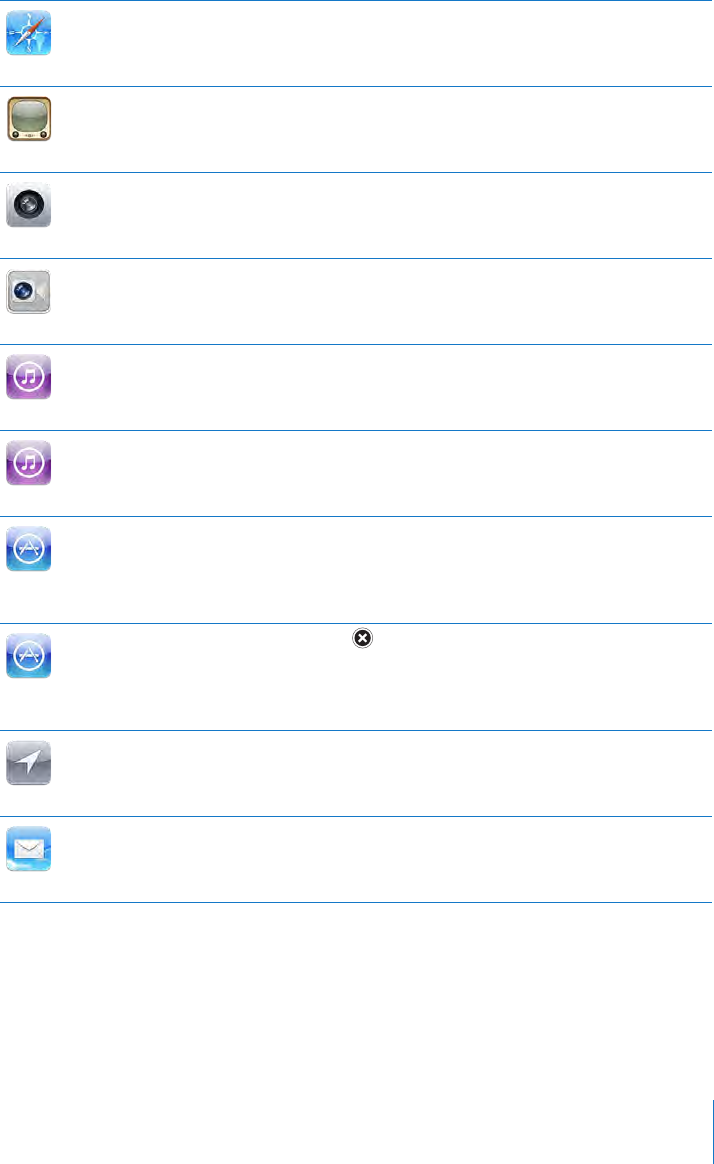Contents
- 1. User manual 1 of 4
- 2. User manual 2 of 4
- 3. User manual 3 of 4
- 4. User manual 4 of 4
User manual 3 of 4

Turn notications on or o: In Settings, choose Notications. Turning o Notications
disables all notications for all apps. You can also silence notications using the Side
Switch (see “Side Switch” on page 160).
Specify which notications you want for Game Center: In Settings, choose
Notications > Game Center, then congure the Sounds, Alerts, and Badges settings.
If Game Center doesn’t appear, turn on Notications.
Set up Game Center information for your Apple ID:
1 Enter your Apple ID and password, then tap Sign In.
You may be asked to provide additional information. If you don’t have an Apple ID, you
can create one by tapping Create New Account.
2 Tap Agree to accept the Game Center Terms & Conditions.
3 Enter a nickname—the name others will see and know you by.
4 Congure your Game Center settings:
To allow other users to invite you to play a game, leave Allow Game Invites turned Â
on. Otherwise, tap to turn it o.
To allow other users to nd you by your email address, leave Find Me By Email Â
turned on. Otherwise, tap to turn it o.
Verify your account email. You can enter a dierent address if you don’t want to use Â
the one for the Apple ID you used to sign in. To conrm this address as yours, you
need to respond to the email that will be sent to that address.
To add other email addresses that people can use to contact you in Game Center, Â
tap Add Another Email.
5 Tap Next when your account is congured.
Change Game Center settings for your Apple ID:
1 Tap Me, then tap your account banner.
2 Tap View Account.
3 Make your changes, then tap Done.
Sign in using a dierent Apple ID:
1 Tap Me, then tap the account banner.
2 Tap Sign Out.
3 Enter the new Apple ID and password, then tap Sign In.
131
Chapter 20 Game Center

Games
Purchasing and Downloading Games
Games for the Game Center are available from the App Store. If you haven’t entered
credit card information for your Apple ID, you’ll be prompted to enter that information
before you can purchase and download games.
Purchase and download games: Tap Games, then tap Find Game Center Games.
The Game Center section of App Store displays games that work with Game Center.
You can browse this section, and purchase and download games from it. See
Chapter 18, “App Store,” on page 119 .
If you want to purchase a game that a friend has, tap the game on your friend’s info
screen to go directly to that game in the App Store.
Playing Games
The Games screen displays the games you download from the App Store. For each
of the games, your number of achievements and your ranking among all the game’s
players are displayed.
Get information about a game: Tap Games, then tap a game. If available, you can
display the game’s leaderboards, see your achievements for the game, and nd out
who’s recently played the game.
Play a game: Tap Games, choose a game, then tap Play.
Depending on the game, the home screen may provide instructions or other
information, and let you view leaderboards and achievements, set game options, and
start a single or multiplayer game. To play against others, you can either invite a friend
or use auto-match to have Game Center nd other players for you. For information
about making friends in Game Center, see “Friends” on page 134.
For multiplayer games, you can also send a game invitation from the Friends screen.
Invite a friend to a multiplayer game from the Friends screen:
1 Tap Friends at the bottom of the screen.
2 Choose a friend.
3 Choose a game and tap Play.
If the game allows or requires additional players, you can choose players to invite,
then tap Next.
4 Enter and send your invitation, then wait for the others to accept.
5 Start the game.
If a friend isn’t available or doesn’t respond to your invitation, you can tap Auto-Match
to have Game Center nd another player for you, or tap Invite Friend to try inviting
some other friend.
132 Chapter 20 Game Center

Other players may invite you to play the game.
Respond to an invitation to play a game: Tap Accept or Decline in the alert
that appears.
You can disable multiplayer games in Restrictions. See “Restrictions” on page 15 8.
You can prevent other players from inviting you to play games by turning o Allow
Game Invites in Game Center settings. See “Your Status and Account Information” on
page 135.
Return to Game Center: Press the Home button, then tap Game Center on the
Home screen.
You can also press the Home button twice quickly and choose Game Center from your
recent apps.
Leaderboards
Some games provide one or more leaderboards to show the ranking of the game’s
players, with their scores, times, or other measures of the players’ success.
See a game’s leaderboard: Tap Games, then choose the game and tap Leaderboard.
You may also be able to view leaderboards from within a game.
If a game has variations (such as Easy, Normal, and Hard), the Categories screen lets
you choose the leaderboard for the game in general, or for one of the variations.
The leaderboard shows the ranking of your friends, and of all players. You may be able
to view leaderboard stats for a specic time period, such as today, this week, or all time.
Rotate iPad to see a leaderboard in landscape orientation.
Start playing a game from the leaderboard: Tap Play in the upper-right corner.
133
Chapter 20 Game Center

Achievements
Some games reward you with bonus points for specic achievements.
See the possible achievements for a game: Tap Games, choose a game, then
tap Achievements.
For each achievement, Game Center shows how many bonus points are awarded,
and whether you’ve completed the achievement. The total points awarded for your
achievements appear at the top. You can get bonus points for a specic achievement
only once.
You may also be able to view achievements from within a game.
Recently Played
Some games let you see which of your friends have recently played the game.
See who’s recently played a game: Tap Games, tap a game, then tap Recently Played.
Get information about a player: Tap a player’s name in the list.
Friends
Game Center puts you in contact with players around the world. You add friends to
Game Center by making a request, or by accepting a request from another player.
Add a friend to Game Center:
1 Tap Friends or Requests.
2 Tap , then enter a friend’s email address or Game Center nickname.
Matching addresses and names from your contacts appear as you type. Tap a contact
to include that person in your request. Tap to browse your contacts.
To add several friends at once, enter additional contacts.
3 Enter a message for your request, then tap Send.
To become a friend, a person must accept your request.
Other players might send you a request. If you receive an alert, you can accept the
request from there, or close it and respond to the request later from the Request
screen. A badge on the Requests button displays the number of outstanding
friend requests.
Respond to a friend request: Tap Requests, tap the name of the person making the
request, then tap Accept, Ignore, or Report a Problem.
When a player accepts another player’s request, they each become the other’s friend.
Friends’ names appear on the Friends screen.
Get information about a friend: Tap the friend’s name.
134 Chapter 20 Game Center

Search for a friend: Tap the status bar to scroll to the top of the screen, then tap the
search eld and start typing. Friends who match your search appear as you type.
A friend’s info page shows how many friends (including you) the person has, the
number of dierent games your friend has played, and how many achievements your
friend has completed. The info screen may also show:
The games you’ve played together Â
The games you have in common Â
Other games your friend has Â
You can tap a game in any of the lists to see your position and your friend’s position
on the overall leaderboard, and your respective accomplishments for the game.
Invite a friend to play a game: Tap Friends, tap the friend’s name, tap a game, then
tap Play. See “Playing Games” on page 132 .
Remove a friend: Tap Friends, tap a name, then tap Unfriend and tap Remove.
If a player is oensive or exhibits inappropriate behavior, you can report the problem.
Report a problem with a friend: Tap Friends, tap the friend’s name, then tap “Report a
Problem.” Describe the problem, then tap Report to send the report.
If you turn o Multiplayer Games in Settings, you can’t send or receive a invitations to
play games. See “Restrictions” on page 158.
Your Status and Account Information
The Me screen summarizes information about your friends, your games, and your
achievements.
The text eld in the center of the screen lets you enter your current status message.
Your status appears along with your nickname in other players’ Friends screens.
Change your status: Tap the status eld to enter or update your status.
View your account information: Tap the account banner, then tap View Account.
You can change or update the following settings:
Nickname Â
Allow game invites Â
Find Me By Email Â
Your email address for Game Center Â
Additional email addresses Â
When you nish, tap Done.
135
Chapter 20 Game Center

You can also sign out and sign in to a dierent account, or create a new account.
Sign out: Tap the account banner, then tap Sign Out.
Sign in to a dierent account: Enter the username and password, then tap Sign In.
Create a new account: Tap Create New Account and follow the onscreen instructions.
Parental Controls
You can use parental controls to manage the way your family adds friends and joins
multiplayer games in Game Center.
Set up Game Center parental controls: Choose Settings > General > Restrictions, then
tap Enable Restrictions. Enter a four-digit passcode, then reenter the passcode.
You can enable restrictions for the following settings:
Multiplayer games Â
Adding friends Â
For more information, see “Restrictions” on page 158.
136 Chapter 20 Game Center

Accessibility 21
In addition to the many features that make iPad easy to use for everyone, iPad includes
universal access features.
Universal Access Features
Universal access features make iPad easy to use for people who have a vision
impairment, are deaf or hard of hearing, or have a physical or learning disability.
The accessibility features on iPad include:
Support for playback of closed-captioned content Â
VoiceOver screen reader Â
Zoom magnication Â
White on Black Â
Large Text Â
Mono Audio Â
Speak Auto-text Â
Support for braille displays Â
Zoom, White on Black, and Mono Audio work with all apps. Large Text works with Mail
and Notes. VoiceOver works with the built-in iPad apps, and with some third-party
apps you can download from the App Store. Closed-captioning works with videos and
podcasts that support it.
For more information about the iPad accessibility features, go to
www.apple.com/accessibility/ipad.
You can turn individual accessibility features on or o in Accessibility settings on iPad.
You can also turn some accessibility features on or o in iTunes when you connect
iPad to your computer.
137

Turn accessibility features on or o in iTunes:
1 Connect iPad to your computer.
2 In iTunes, select iPad in the sidebar.
3 In the Summary pane, click Congure Universal Access in the Options section.
4 Select the accessibility features you want to use and click OK.
The features you select are available immediately on iPad when you click OK.
VoiceOver
VoiceOver describes aloud what appears onscreen, so that you can use iPad without
seeing it.
VoiceOver tells you about each element on the screen as you select it. When you select
an element, a black rectangle encloses it (for the benet of those who can see the
screen) and VoiceOver speaks the name or describes the item. The enclosing rectangle
is referred to as the VoiceOver cursor.
Touch the screen or drag your ngers to hear dierent items on the screen. To interact
with items on the screen, such as buttons and links, use the gestures described in
“VoiceOver Gestures” on page 140. When you select text, VoiceOver reads the text.
If you turn on Speak Hints, VoiceOver may tell you the name of the item. When you
select a control (such as a button or switch), VoiceOver provides instructions for you—
for example, “double-tap to open.”
When you go to a new screen, VoiceOver plays a sound and automatically selects and
speaks the rst element of the screen (typically, the item in the upper-left corner).
VoiceOver also lets you know when the display changes to landscape or portrait
orientation, and when the screen is locked or unlocked.
Note: VoiceOver speaks in the language specied in International settings, which may
be inuenced by the Region Locale setting. VoiceOver is available in many languages,
but not all.
138 Chapter 21 Accessibility

Setting Up VoiceOver
VoiceOver changes the gestures you use to control iPad. Once you turn VoiceOver on,
you must use VoiceOver gestures to operate iPad—even to turn VoiceOver o again
and resume standard operation.
Turn VoiceOver on or o on iPad: In Settings, choose General > Accessibility >
VoiceOver, then tap the VoiceOver On/O switch.
Turn VoiceOver on or o in iTunes: Select iPad in the iTunes sidebar. In the Options
section of the Summary pane, click Congure Universal Access. Select VoiceOver, then
click OK.
You can also set Triple-click Home to turn VoiceOver on or o. See “Triple-Click
Home” on page 150.
Note: You cannot use VoiceOver and Full-screen Zoom at the same time.
VoiceOver Settings
You can set VoiceOver to give spoken hints, increase or decrease the speaking rate, or
give typing feedback.
Turn spoken hints on or o: In Settings, choose General > Accessibility > VoiceOver,
then tap the Speak Hints On/O switch. Spoken hints are turned on by default.
Set the VoiceOver speaking rate: In Settings, choose General > Accessibility >
VoiceOver, then adjust the Speaking Rate slider.
You can choose what kind of feedback you get when you type. You can set VoiceOver
to speak characters, words, both, or nothing. If you choose to hear both characters and
words, VoiceOver speaks each character as you type it, then speaks the whole word
when you enter a space or punctuation.
Choose typing feedback: In Settings, choose General > Accessibility > VoiceOver >
Typing Feedback. You can choose Characters, Words, Characters and Words, or Nothing
for software keyboards and for Apple Wireless Keyboards.
Use phonetics In Settings, choose General > Accessibility > VoiceOver, then tap
the Use Phonetics switch to turn it on.
Use this feature when you type or read character-by-character,
to help make clear which characters were spoken. When Use
Phonetics is turned on, Voiceover rst speaks the character, then
speaks a word beginning with the character. For example, if you
type the character “f,” VoiceOver speaks “f,” and then a moment
later, “foxtrot.”
Use pitch change In Settings, choose General > Accessibility > VoiceOver, then tap
the Use Pitch Change switch to turn it on.
VoiceOver uses a higher pitch when entering a letter, and a lower
pitch when deleting a letter. VoiceOver also uses a higher pitch
when speaking the rst item of a group (such as a list or table)
and a lower pitch when speaking the last item of a group.
139
Chapter 21 Accessibility

By default, VoiceOver uses the language that’s set for iPad. You can set a dierent
language for VoiceOver.
Change the language spoken by VoiceOver: In Settings, choose General >
International > Language, then select a language and tap OK.
Some languages may be inuenced by the Region Local setting. In Settings, choose
General > International > Region Format, then select the format.
Set the rotor options for web browsing: In Settings, choose General > Accessibility >
VoiceOver > Web Rotor. Tap to select or deselect options. To change the position of an
item in the list, touch next to the item, then drag up or down.
Select the languages available in the Language rotor: In Settings, choose General
> Accessibility > VoiceOver > Language Rotor and tap to select the language or
languages you want to appear in the Language rotor. To change the position of a
language in the list, touch next to the language and drag up or down.
The Language rotor is always available when you’ve selected more than one language.
VoiceOver Gestures
When VoiceOver is turned on, it changes the gestures you use to control iPad, so that
you can hear descriptions without activating buttons. These VoiceOver gestures let you
move around the screen and control the individual elements that you select. Some
VoiceOver gestures use two, three, or four ngers to tap or ick. For best results when
using more than one nger, relax and let your ngers touch the screen with some
space between them.
There are many ways to enter VoiceOver gestures. For example, you can two-nger tap
by using either two ngers on one hand, or one nger on each hand. You can also use
your thumbs. Try dierent techniques to discover what works best for you.
If your gestures don’t work, try quicker movements, especially for double-tapping and
icking gestures. To ick, try quickly brushing the screen with your nger or ngers.
Practice gestures: In Settings, choose General > Accessibility > VoiceOver > Practice
Gestures, then tap the Practice VoiceOver Gestures button. Practice the gestures
described in “VoiceOver Settings,” below. When you nish practicing, tap Done.
Make single-nger icking gestures quickly, to distinguish them from dragging gestures.
140 Chapter 21 Accessibility

Here’s a summary of VoiceOver gestures:
Navigate and Read
ÂTap: Speak item.
ÂFlick right or left: Select the next or previous item.
ÂFlick up or down: The eect varies depending on the Rotor Control setting. See
“Using VoiceOver” on page 143.
ÂTwo-nger tap: Stop speaking the current item.
ÂTwo-nger ick up: Read all, from the top of the screen.
ÂTwo-nger ick down: Read all, from the current position.
ÂThree-nger ick up or down: Scroll one page at a time.
ÂThree-nger ick right or left: Go to the next or previous page (for example, on the
Home screen or in Safari).
ÂThree-nger tap: Speak the scroll status (which page or rows are visible).
ÂFour-nger ick up or down: Go to the rst or last element on a page.
ÂFour-nger ick right or left: Go to the next or previous section (for example, on
a webpage).
Select and Activate
ÂDouble-tap: Activate selected item.
ÂTouch an item with one nger, tap the screen with another nger (“split-tapping”):
Activate item.
ÂDouble-tap and hold (1 second) + standard gesture: Use a standard gesture.
The double-tap and hold gesture tells iPad to interpret the subsequent gesture as
standard. For example, you can double-tap and hold, and then without lifting your
nger, drag your nger to slide a switch.
You can use standard gestures when VoiceOver is turned on, by double-tapping
and holding your nger on the screen. A series of tones indicates that normal
gestures are in force. They remain in eect until you lift your nger, then VoiceOver
gestures resume.
ÂTwo-nger double tap: Play or pause in iPod, YouTube, or Photos. Start or stop
the stopwatch.
ÂThree-nger double tap: Mute or unmute VoiceOver.
ÂThree-nger triple tap: Turn the display on or o.
141
Chapter 21 Accessibility

Rotor Control
The rotor is a virtual control that acts like a physical dial when VoiceOver is turned
on. Use the rotor to change VoiceOver settings and to access additional commands
and features.
Operate the rotor: Rotate two ngers on the iPad screen to “turn” the dial and choose
items on the rotor. Flick up and down to use the selected item.
The eect of the rotor depends on what you’re doing. For example, if you’re reading
text in an email, you can use the rotor to switch between hearing text spoken word-
by-word, character-by-character, or line-by-line when you ick up or down. When you
browse a webpage, use the rotor to choose whether you hear text word-by-word or
character-by-character, hear just the headers, hear just the links (all of them, visited
links, or links not yet visited), hear form elements, or hear descriptions of images. You
can use the rotor setting to hear all of the text, or to jump from one element of a
certain type (such as headers or links) to another.
Reading text
Select and hear text by:
Character Â
Word Â
Line Â
Browsing a webpage
Select and hear text by:
Character Â
Word Â
Line Â
Heading Â
Link Â
Visited link Â
Non-visited link Â
In-page link Â
Form control Â
Table Â
Row (when navigating a table) Â
List Â
Landmark Â
Image Â
Static text Â
Zoom in or out
142 Chapter 21 Accessibility

Entering text
Move insertion point and hear text by:
Character Â
Word Â
Line Â
Select edit function
Select language
Using a control
Select and hear values by:
Character Â
Word Â
Line Â
Adjust the value of the control object
Using VoiceOver
Unlock iPad: Select the Unlock button, then double-tap the screen.
Select items on the screen: Drag your nger across the screen. VoiceOver identies
each element as you touch it. You can also move systematically from one element
to the next by icking left or right with one nger. Elements are selected from left
to right, top to bottom. Flick right to go to the next element, or ick left to go to the
previous element.
“Tap” a selected item when VoiceOver is turned on: Double-tap anywhere on
the screen.
Speak the text of an element, character-by-character, word-by-word, or line-by-line:
With the element selected, ick up or down with one nger. Flick down to read the
next character, or ick up to read the previous character. Twist the rotor control to read
word-by-word or line-by-line.
Adjust a slider: With one nger, ick up to increase the setting or down to decrease
the setting. VoiceOver speaks the setting as you adjust it.
Scroll a list or area of the screen: Flick up or down with three ngers. Flick down to
page down, or ick up to page up. When paging through a list, VoiceOver speaks the
range of items displayed (for example, “showing rows 5 through 10”).
Scroll continuously through a list: Double-tap and hold. When you hear a series of
tones, you can move your nger up or down to scroll the list. Continuous scrolling
stops when you lift your nger.
143
Chapter 21 Accessibility

Use an index: Some lists have an alphabetical index along the right side. The index
can’t be selected by icking between elements; you must tap the index to select
it. With the index selected, ick up or down to move along the index. You can also
double-tap, then slide your nger up or down.
Rearrange the Home screen: On the Home screen, select the icon you want to move.
Double-tap and hold, then drag the icon. VoiceOver speaks the row and column
position as your drag the icon. Release the icon when it’s in the location you want. You
can drag additional icons. Drag an item to the left or right edge of the screen to move
it to a dierent page of the Home screen. When you nish rearranging the icons, press
the Home button.
You can turn speaking o, stop speaking an item, turn the display o, or have
VoiceOver speak the entire screen.
Mute VoiceOver Double-tap with three ngers. Double-tap with three
ngers again to turn speaking back on. To mute only
VoiceOver sounds, set the Side Switch to silent.
Stop speaking an item Tap once with two ngers. Tap again with two ngers to
resume speaking. Speaking automatically resumes when
you select another item.
Turn o the display while you use
VoiceOver
Triple-tap with three ngers. Repeat to turn the display
on again.
Speak the entire screen from the top Flick up with two ngers.
Speak from the current item to the
bottom of screen
Flick down with two ngers.
You can hear iPad status information by tapping the status bar at the top of the screen.
This includes the time, battery life, Wi-Fi signal strength, and more.
Entering and Editing Text
When you select a text eld with VoiceOver, you can use the onscreen keyboard to
enter text. You can use the editing features of iPad to cut, copy, or paste in the text eld.
Note: Safari doesn’t support copying webpage content. The editing features work only
in editable text elds.
Enter text:
1 Use VoiceOver to select an editable text eld, then double-tap to display the insertion
point and bring up the onscreen keyboard. If the eld already contains text, the
insertion point is placed at the beginning or at the end of the text. Double-tap again
to place the insertion point at the opposite end. VoiceOver tells you the position of the
insertion point.
144 Chapter 21 Accessibility

The insertion point and onscreen keyboard may appear automatically when you
select a text eld. VoiceOver announces when you’re in editing mode—based on the
rotor setting.
2 To type, do one of the following:
“Touch-type” by dragging your nger to select a key, then lifting your nger to enter Â
the character.
“Standard-type” by icking left or right to select a key on the keyboard, then double- Â
tapping to enter the character.
Enter a character by dragging your nger around the keyboard to select a key, and, Â
while holding the key with one nger, tapping the screen with another nger.
VoiceOver speaks the key when it’s selected, and again when it’s entered.
Enter an accented character: Double-tap and hold, until you hear a sound indicating
that the alternate characters have appeared, then drag left or right to select and hear
the choices. Release your nger to enter the current selection.
Move the insertion point: Flick up or down to move the insertion point forward or
backward in the text. VoiceOver makes a sound when the insertion point moves, and
speaks the character that the insertion point moved across. Use the rotor to choose
whether you want to move the insertion point by characters, words, or lines.
Select text: Use the rotor to choose edit. Flick up or down to choose between the
Select and Select All functions, then double-tap. If you chose Select, the word closest
to the insertion point is selected when you double-tap. If you chose Select All, all the
text is selected.
Pinch to increase or decrease the selection.
Cut, copy, or paste: Make sure the rotor is set to edit. With text selected, ick up or
down to choose Cut, Copy, or Paste, then double-tap.
Undo: Shake iPad, or ick left or right to choose the action to undo, then double-tap.
Change the pitch: In Settings, choose General > Accessibility > VoiceOver, then tap the
Use Pitch Change button. Then, when you delete a letter, it’s spoken with a lower pitch.
Speak keys phonetically: In Settings, choose General > Accessibility > VoiceOver,
then tap the Use Phonetics button. Then, when you pause on a key, VoiceOver speaks
the letter of that key phonetically (for example, alpha for a, bravo for b, charlie for c,
and so on).
145
Chapter 21 Accessibility

Controlling VoiceOver Using an Apple Wireless Keyboard
You can control VoiceOver using an Apple Wireless Keyboard paired with iPad. See
“Using Bluetooth Devices” on page 43.
The VoiceOver keyboard commands let you navigate the screen, select items, read
screen contents, adjust the rotor, and perform other VoiceOver actions. All the keyboard
commands (except one) include Control-Option, abbreviated in the table below as “VO.”
VoiceOver Help speaks keys or keyboard commands as you type them. You can
use VoiceOver Help to learn the keyboard layout and the actions associated with
key combinations.
VoiceOver Keyboard Commands
VO = Control-Option
Read all, starting from the current position VO–A
Read from the top VO–B
Move to the status bar VO–M
Press the Home button VO–H
Select the next or previous item VO–Right Arrow or VO–Left Arrow
Tap an item VO–Space bar
Double-tap with two ngers VO–”-”
Choose the next or previous rotor item VO–Up Arrow or VO–Down Arrow
Choose the next or previous speech rotor item VO–Command–Left Arrow or VO–Command–
Right Arrow
Adjust speech rotor item VO–Command–Up Arrow or VO–Command–
Down Arrow
Mute or unmute VoiceOver VO–S
Turn the screen curtain on or o VO–Shift-S
Turn on VoiceOver help VO–K
Return to the previous screen, or turn o
VoiceOver help
Escape
Quick Nav
Turn on Quick Nav to control VoiceOver using the arrow keys. Quick Nav is o by default.
Turn Quick Nav on or o Left Arrow–Right Arrow
Select the next or previous item Right Arrow or Left Arrow
Select the next or previous item specied
by the rotor setting
Up Arrow or Down Arrow
146 Chapter 21 Accessibility

Select the rst or last item Control–Up Arrow or Control–Down Arrow
“Tap” an item Up Arrow–Down Arrow
Scroll up, down, left, or right Option–Up Arrow, Option–Down Arrow,
Option–Left Arrow, or Option–Right Arrow
Change the rotor Up Arrow–Left Arrow or Up Arrow–Right Arrow
Using Maps
Use VoiceOver to zoom in or out, select pins, and get information about locations.
Zoom in or out: Use the rotor to choose zoom mode, then ick up or down to zoom
in or out.
Select a pin: Touch a pin, or ick left or right to move from one item to another.
Get information about a location: With a pin selected, double-tap to display the
information ag. Flick left or right to select the ag, then double-tap to display the
information page.
Using a Braille Display with VoiceOver
Setting Up a Braille Display
You can use a refreshable Bluetooth braille display to read VoiceOver output in
braille. In addition, braille displays with input keys and other controls can be used
to control iPad when VoiceOver is turned on. iPad works with many of the most
popular wireless braille displays. For a list of supported braille displays, see
www.apple.com/accessibility/voiceover/devicesupport.
Set up a braille display:
1 Turn on the braille display.
2 On iPad, turn on Bluetooth.
In Settings, choose General > Bluetooth, then tap the Bluetooth switch.
3 In Settings, choose General > Accessibility > VoiceOver > Braille, then choose the
braille display.
Turn contracted braille on or o: In Settings, choose General > Accessibility >
VoiceOver > Braille, then tap the Contracted Braille switch.
Choosing a Language
The braille display uses the language that’s set for Voice Control. By default, this is the
language that’s set for iPad in Settings > International > Language. You can use the
VoiceOver language setting to set a dierent language for VoiceOver and braille displays.
Set the language for VoiceOver: In Settings, choose General > International >
Voice Control, then choose the language.
If you change the language for iPad, you may need to reset the language for VoiceOver
and your braille display.
147
Chapter 21 Accessibility

Controlling VoiceOver with Your Braille Display
You can set the leftmost or rightmost cell of your braille display to provide system
status and other information:
Announcement History contains an unread message Â
The current Announcement History message has not been read Â
VoiceOver speech is muted Â
The iPad battery is low (less than 20% charge) Â
iPad is in landscape orientation Â
The screen display is turned o Â
The current line contains additional text to the left Â
The current line contains additional text to the right Â
Set the leftmost or rightmost cell to display status information: In Settings, choose
General > Accessibility > VoiceOver > Braille > Status Cell, then tap Left or Right.
See an expanded description of the status cell: On your braille display, press the
status cell’s router button.
Zoom
The Zoom accessibility feature lets you magnify the entire screen to help you see
what’s on the display.
Turn Zoom on or o: In Settings, choose General > Accessibility > Zoom, then tap the
Zoom On/O switch. Or, use Triple-click Home, (see “Triple-Click Home” on page 150).
Zoom in or out: Double-tap the screen with three ngers. By default, the screen is
magnied 200 percent. If you manually change the magnication (by using the tap-
and-drag gesture, described below), iPad automatically returns to that magnication
when you zoom in by double-tapping with three ngers.
Increase magnication: With three ngers, tap and drag up to increase magnication
or down to decrease magnication. The tap-and-drag gesture is similar to a double-tap,
except you don’t lift your ngers on the second tap—instead, drag your ngers on
the screen.
Move around the screen: While zoomed in, drag the screen with three ngers.
Hold one nger near the edge of the display to pan to that side of the screen image.
Move your nger closer to the edge to pan more quickly. When you open a new
screen, Zoom always goes to the upper-center of the screen.
While using Zoom with an Apple Wireless Keyboard (see “Controlling VoiceOver Using
an Apple Wireless Keyboard” on page 14 6), the screen image follows the insertion
point, keeping it in the center of the display.
148 Chapter 21 Accessibility

Large Text
Large Text lets you make the text larger in Mail and Notes. You can choose 20-point,
24-point, 32-point, 40-point, 48-point, or 56-point text.
Set the text size: In Settings, choose General > Accessibility, tap Large Text, then tap
the text size you want.
White on Black
Use White on Black to invert the colors on the iPad display, which may make it
easier to read the screen. When White on Black is turned on, the screen looks like a
photographic negative.
Invert the screen’s colors: In Settings, choose General > Accessibility, then tap “White
on Black.”
Mono Audio
Mono Audio combines the sound of the left and right channels into a mono signal
played on both sides. This lets users with hearing impairment in one ear hear the
entire sound signal with the other ear.
Turn Mono Audio on or o: In Settings, choose General > Accessibility, then tap the
Mono Audio button.
Speak Auto-Text
Speak Auto-text speaks the text corrections and suggestions iPad makes when you type.
Turn Speak Auto-text on or o: In Settings, choose General > Accessibility, then tap
the Speak Auto-text button.
Speak Auto-text also works with VoiceOver or Zoom.
149
Chapter 21 Accessibility

Triple-Click Home
Triple-click Home is an easy way to turn some accessibility features on or o by
quickly pressing the Home button three times. You can set Triple-click Home to turn
VoiceOver on or o, turn White on Black on or o, or ask if you would like to triple-click
the Home button to:
Turn VoiceOver on or o Â
Turn White on Black on or o Â
Turn Zoom on or o Â
Triple-click Home is normally turned o.
Set the Triple-click Home function: In Settings, choose General > Accessibility >
Triple-click Home, then choose the function you want.
Closed Captioning and Other Helpful Features
Many standard features available on iPad also help make it accessible to all users,
including those with disabilities.
Widescreen Keyboards
All the built-in iPad apps show a larger onscreen keyboard when you rotate iPad to
landscape view. You can also type using an Apple Wireless Keyboard.
Minimum Font Size for Mail Messages
To increase readability, set the minimum font size for Mail message text to Large,
Extra Large, or Giant. See “Mail” on page 164.
Universal Access in Mac OS X
Take advantage of the Universal Access features in Mac OS X when you use iTunes to
sync information and content from your iTunes library to iPad. In the Finder, choose
Help > Mac Help, then search for “universal access.”
For more information about iPad and Mac OS X accessibility features, go to
www.apple.com/accessibility.
Closed Captioning
You can turn on closed captioning for videos in Video settings. See “Video” on
page 168.
150 Chapter 21 Accessibility

Settings 22
About Settings
Use Settings to personalize iPad apps, set the date and time, congure your network
connection, and change other iPad settings.
Airplane Mode
Airplane Mode disables the wireless features of iPad to comply with airline regulations.
Turn Airplane Mode on or o: Tap Settings and turn Airplane Mode on or o.
When airplane mode is on, a small appears in the status bar at the top of the
screen. Wi-Fi and Bluetooth signals aren’t emitted, and GPS reception is turned o,
disabling many iPad features. You won’t be able to:
Send or receive email Â
Browse the Internet Â
Sync your contacts, calendars, or bookmarks Â
Stream YouTube videos Â
Get weather reports Â
Get map locations Â
Use the iTunes Store, iBookstore, or the App Store Â
Use Game Center Â
If allowed by the aircraft operator and applicable laws and regulations, you can
continue to use iPad to:
Listen to music or watch videos Â
Check your calendar Â
View photos Â
151

Take notes Â
Read email messages stored on iPad Â
Where allowed by the aircraft operator and applicable laws and regulations, you can
turn Wi-Fi back on, so you can:
Send and receive email Â
Browse the Internet Â
Sync your contacts, calendars, and bookmarks Â
Stream YouTube videos Â
Use the iTunes Store, iBookstore, or the App Store Â
Use Game Center Â
You may also be allowed to turn on Bluetooth and use Bluetooth devices with iPad.
VPN
This setting appears when you congure a Virtual Private Network (VPN). See “VPN
Access” on page 172.
Turn VPN on or o: Tap VPN to turn it on or o.
Set up a VPN conguration: Choose General > Network > VPN.
Wi-Fi
Wi-Fi settings determine whether iPad uses local Wi-Fi networks to connect to the
Internet. If a Wi-Fi network isn’t available, or if you turn Wi-Fi o, then iPad connects to
the Internet over your cellular data network (iPad Wi-Fi + 3G).
Turn Wi-Fi on or o: Choose Wi-Fi, then turn Wi-Fi on or o.
Join a Wi-Fi network: Choose Wi-Fi, wait a moment as iPad detects networks in range,
then select a network. If necessary, enter a password and tap Join. (Networks that
require a password appear with a lock icon.)
Once you join a Wi-Fi network, iPad automatically joins it whenever the network is
in range. If more than one previous network is in range, iPad joins the one most
recently used.
When iPad joins a Wi-Fi network, the Wi-Fi icon in the status bar at the top of the
screen shows signal strength. The more bars you see, the stronger the signal.
Set iPad to ask if you want to join a new network: Choose Wi-Fi, then turn “Ask to
Join Networks” on or o.
152 Chapter 22 Settings

When you try to access the Internet—by using Safari or Mail for example—and you
aren’t in range of a Wi-Fi network you’ve previously used, this option tells iPad to
look for another network. iPad displays a list of available Wi-Fi networks that you
can choose from. Networks that require a password show a lock icon. If “Ask to
Join Networks” is turned o and a previously used Wi-Fi or cellular data network isn’t
available, you must manually join a network to connect to the Internet.
Forget a network, so iPad doesn’t join it automatically: Choose Wi-Fi, then tap
next to a network you’ve joined before. Then tap “Forget this Network.”
Join a closed Wi-Fi network: To join a Wi-Fi network that isn’t shown in the list
of networks, choose Wi-Fi > Other, then enter the network name. If the network
requires a password, tap Security, tap the type of security the network uses, and
enter the password.
To connect to a closed network, you must know the network name, password, and
security type.
Some Wi-Fi networks may require you to provide additional information, such as a
client ID or static IP address. Ask your network administrator what settings to use.
Adjust settings to connect to a Wi-Fi network: Choose Wi-Fi, then tap next to
a network.
Notications
This setting appears when you open an app, such as Game Center, that uses the Apple
Push Notication service. Push notications alert you to new information, even when
the app isn’t running. Notications vary by app, but may include text or sound alerts,
and a numbered badge on the app icon on the Home screen. Turn notications o if
you don’t want to be notied, or to conserve battery life. See “Side Switch” on page 160.
Turn all notications on or o: Tap Notications, then turn Notications on or o.
Turn sounds, alerts, or badges on or o for an app: Tap Notications, choose an app
from the list, then choose the types of notications you want to turn on or o.
Location Services
Location Services allows apps such as Maps to gather and use data based on your
location. Location Services doesn’t connect the data it collects with your personally
identiable information. If you have Wi-Fi turned on, your approximate location is
determined using available information from local Wi-Fi networks. iPad Wi-Fi + 3G also
uses cellular networks and GPS to determine your location.
When an app is using location services, appears in the status bar.
153
Chapter 22 Settings

Every app that uses location services appears on the Location Services settings screen,
showing whether location services is turned on or o for that app. appears for each
app that has requested your location within the last 24 hours. If you don’t want to use
this feature, you can turn location services o for some apps or for all apps. If you turn
location services o, you’re prompted to turn it on again the next time an app tries to
use the feature.
Turn location services on or o for all apps: Choose General > Location Services,
then turn location services on or o.
Turn location services on or o for some apps: Choose General > Location Services,
choose an app, then turn location services on or o for that app.
To conserve battery life, turn location services o when you’re not using it.
Carrier
This setting appears on iPad Wi-Fi + 3G when you’re outside of your carrier’s
network and other local carrier data networks are available to use for cellular
network Internet connections.
Select a carrier: Choose Carrier and select the network you want to use.
Cellular Data
Use Cellular Data settings (iPad Wi-Fi + 3G) to turn Data Roaming on or o, view or
change your account information, or add a Personal Identication Number (PIN) to
lock the micro-SIM card (on some models).
Turn the cellular data network on or o: Choose Cellular Data, then turn cellular data
on or o.
Turn data roaming on or o: Choose Data Roaming, then turn data roaming on or o.
View your account information: Tap View Account to view or change your account
information.
Add a SIM PIN (on some models): Tap SIM PIN and add a PIN to lock your micro-SIM
card.
Brightness & Wallpaper
Use Brightness settings to adjust the screen brightness to a comfortable level. Use
Wallpaper settings to personalize iPad.
Adjust the screen brightness: Choose Brightness, then drag the slider.
154 Chapter 22 Settings

Set whether iPad adjusts the screen brightness automatically: Choose Brightness,
then turn Auto-Brightness on or o. If Auto-Brightness is on, iPad adjusts the screen
brightness for current light conditions using the built-in ambient light sensor. To
manually adjust the screen brightness, see “Adjusting Brightness” on page 17.
A wallpaper background picture is displayed on the Lock screen and on the Home
screen. You can choose one of the images that came with iPad, an image you’ve saved
to iPad, or a photo in your Photo Library. An image that’s at least 1024 x 1024 pixels
lls the screen when iPad is rotated.
Set wallpaper: Choose Wallpaper, then choose an image and then do one of
the following:
ÂTo use the image as the background for the Lock screen, tap Set Lock Screen.
ÂTo use the image as the background for the Home screen, tap Set Home Screen.
ÂTo use the image as the background for both the Lock screen and Home screen,
tap Set Both.
Picture Frame
Picture Frame mode turns iPad into an animated picture frame. Choose which
transitions and photos to display. Choose whether to zoom in on faces and whether to
shue photos.
Activate Picture Frame: Tap on the Lock screen.
General
General settings include date and time, security, network, and other settings that aect
more than one app. This is also where you can nd information about your iPad, or
reset iPad to its original state.
About
Choose General > About to get information about iPad, including:
Number of songs, videos, photos, and apps Â
Total storage capacity Â
Space available Â
Software version Â
Model and serial numbers Â
Cellular data number (iPad Wi-Fi + 3G), and Wi-Fi and Bluetooth addresses Â
Modem rmware version of the cellular transmitter (iPad Wi-Fi + 3G) Â
IMEI (International Mobile Equipment Identity) and ICCID (Integrated Circuit Card Â
Identier, or Smart Card) numbers (iPad Wi-Fi + 3G)
Legal and Regulatory information Â
155
Chapter 22 Settings

Usage
Show battery percentage: Turn Battery Percentage on to display the percentage of
battery charge next to the battery icon in the upper-right corner.
See cellular network data: On iPad Wi-Fi + 3G, see the amount of data sent and
received using a cellular data network.
Reset your usage statistics: Tap Reset Statistics to clear accumulated data and statistics.
Sounds
Adjust the ringer and alert volume: Choose General > Sounds and drag the slider. If
“Change with Buttons” is turned on, use the volume buttons on the side of iPad. The
volume buttons don’t change the ringer and alert volume if a song or video is playing.
Use the volume buttons to adjust the ringer and alert volume: Choose General >
Sounds, then tap “Change with Buttons.”
Set the ringtone: Choose General > Sounds > Ringtone, then choose a ringtone.
Set alert and eects sounds: Choose General > Sounds, then turn items on or o.
When “Change with Buttons” is on, iPad plays sounds for alerts and eects that are
turned on.
You can set iPad to play a sound whenever you:
Get a new email message Â
Send an email message Â
Have an Calendar event that you’ve set to alert you Â
Lock iPad Â
Type using the onscreen keyboard Â
Network
Use Network settings to congure a VPN (virtual private network) connection or
access your Wi-Fi settings.
Add a new VPN conguration: Choose General > Network > VPN > Add VPN
Conguration.
VPNs used within organizations allow you to communicate private information
securely over a non-private network. You may need to congure VPN, for example,
to access your work email on iPad.
iPad can connect to any VPN that uses the L2TP, PPTP, or Cisco IPSec protocol. VPN
works over both Wi-Fi and cellular data network (iPad Wi-Fi + 3G) connections.
Ask your network administrator which settings to use. In most cases, if you’ve set up
VPN on your computer, you can use the same VPN settings for iPad.
Once you enter VPN settings, a VPN switch appears in the Settings menu, which you
can use to turn VPN on or o.
156 Chapter 22 Settings

VPN may also be automatically set up by a conguration prole. See “Using
Conguration Proles” on page 171.
Change a VPN conguration: Choose General > Network > VPN and tap the
conguration you want to update.
Turn VPN on or o: Tap Settings, then turn VPN on or o. When VPN is on, you see the
icon in the status bar at the top of the screen.
Delete a VPN conguration: Choose General > Network > VPN, tap the blue arrow
to the right of the conguration name, then tap Delete VPN at the bottom of the
conguration screen.
Bluetooth
iPad can connect wirelessly to an Apple Wireless Keyboard for wireless typing or to
Bluetooth headphones for wireless listening. See “Using Bluetooth Devices” on page 43.
Turn Bluetooth on or o: Choose General > Bluetooth and turn Bluetooth on or o.
When Bluetooth is on, you see the Bluetooth icon in the status bar at the top of
the screen.
Spotlight Search
You can specify the content areas you want to search on iPad using Spotlight.
Set the content areas Spotlight searches: Choose General > Spotlight Search and tap
an item to select or deselect it.
Set the search result order: Choose General > Spotlight Search, touch next to an
item, and drag it up or down to rearrange the search order.
Auto-Lock
Set Auto-Lock to turn o the display and prevent unintended operation of your iPad.
Set the amount of time before iPad locks: Choose General > Auto-Lock and choose
a time.
Passcode Lock
Initially, iPad doesn’t require you to enter a passcode to unlock it. For security, you can
create a passcode.
Set a passcode: Choose General > Passcode Lock > Turn Passcode On. Enter a 4-digit
passcode, then enter the passcode again to verify it. iPad then requires you to enter
the passcode to unlock it or to display the passcode lock settings.
Set how long before your passcode is required: Choose General > Passcode Lock,
then enter your passcode. Tap Require Passcode and select how long iPad can be idle
before you need to enter a passcode to unlock it.
Turn the passcode o: Choose General > Passcode Lock > Turn Passcode O, then
enter your passcode.
157
Chapter 22 Settings

Change the passcode: Choose General > Passcode Lock, enter your passcode,
then tap Change Passcode. Enter your passcode again, then enter and reenter your
new passcode.
If you forget your passcode, you must restore the iPad software. See “Removing a
Backup” on page 182.
Turn Simple Passcode on or o: Choose General > Passcode Lock, then turn Simple
Passcode on or o.
A simple passcode is a four-digit number. To increase security, turn o Simple Passcode
and use a longer passcode that has a combination of numbers, letters, punctuation,
and special characters.
Turn Picture Frame on or o: Choose General > Passcode Lock and turn Picture Frame
on or o.
When Picture Frame is on, iPad displays your photos from the locked screen. See
“Picture Frame” on page 155.
Erase all data after ten failed passcode attempts: Choose General > Passcode Lock,
enter your passcode, and tap Erase Data to turn it on.
After ten failed passcode attempts, your settings are reset to their original values, all
your information and media are erased, and the encryption key is removed.
iPad Cover Lock/Unlock
You can automatically lock or unlock iPad 2 when you use it with the iPad Smart Cover
(available separately).
Use the cover to lock or unlock iPad: Choose General > iPad Cover Lock/Unlock, then
tap On. iPad automatically locks and goes to sleep when you close the cover, and then
wakes and unlocks when you open the cover.
If you have a passcode set, you have to enter it when you open the cover to wake iPad.
Restrictions
You can set restrictions for the use of some apps and for iPod content on iPad. For
example, parents can restrict access to explicit content, or turn o YouTube access.
Turn on restrictions:
1 Choose General > Restrictions, then tap Enable Restrictions.
2 Enter a four-digit passcode.
3 Reenter the passcode.
Turn o restrictions: Choose General > Restrictions, then enter the passcode.
Tap Disable Restrictions, then reenter the passcode.
If you forget your passcode, you must restore the iPad software using iTunes.
See “Removing a Backup” on page 182.
158 Chapter 22 Settings

Set app restrictions: Set the restrictions you want by tapping individual controls on or
o. Initially, all controls are on (unrestricted). Tap an item to turn it o and restrict its use.
Safari
Safari is disabled and its icon is removed from the Home screen. You cannot use
Safari to browse the web or access web clips. Other third-party apps may allow web
browsing even if Safari is disabled.
YouTube
YouTube is disabled and its icon is removed from the Home screen.
Camera
The Camera app is disabled and its icon is removed from the Home screen. You cannot
take photos or videos with iPad.
FaceTime
You cannot make or receive FaceTime video chats.
iTunes
The iTunes Store is disabled and its icon is removed from the Home screen. You cannot
preview, purchase, or download content.
Ping
Ping is disabled. You cannot follow artists or other people.
Installing
Apps
Installing apps is disabled and the App Store icon is removed from the Home screen.
Deleting
Apps
Deleting apps from iPad is disabled. doesn’t appear on app icons when you
customize the Home screen.
Location
Location Services settings cannot be changed.
Accounts
Mail account settings cannot be changed.
Restrict purchases within apps: Turn o In-App Purchases. When enabled, this feature
allows you to purchase additional content or features within apps downloaded from
the App Store.
159
Chapter 22 Settings

Set content restrictions: Tap Ratings For, then select a country in the list. You can set
restrictions using that country’s ratings system for the following categories of content:
Music & Podcasts Â
Movies Â
TV Shows Â
Apps Â
In the United States, for example, to allow only movies rated PG or below, tap Movies,
then select PG from the list.
Note: Not all countries or regions have a rating system.
Restrict multiplayer games: Turn o Multiplayer Games.
When Multiplayer Games is turned o, you can’t request a match, or send or receive
invitations to play games or add friends in Game Center.
Restrict adding friends: Turn o Adding Friends.
When Adding Friends is turned o, you can’t make or receive friend requests in Game
Center. You can continue to play with existing friends if Multiplayer Games is turned on.
Side Switch
You can use the Side Switch to lock screen orientation or to silence notications and
sound eects.
Lock the screen in portrait or landscape orientation: Choose General > Use the Side
Switch…, then tap Lock Rotation.
Mute notications and other sound eects: Choose General > Use the Side Switch…,
then tap Mute.
The Side Switch doesn’t mute audio or video playback.
Date and Time
These settings apply to the time shown in the status bar at the top of the screen,
and in world clocks and calendars.
Set whether iPad shows 24-hour time or 12-hour time: Choose General > Date
& Time and turn 24-Hour Time on or o. (24-Hour Time may not be available in all
countries or regions.)
Set whether iPad updates the date and time automatically: Choose General >
Date & Time, then turn Set Automatically on or o.
Set the date and time manually: Choose General > Date & Time, then turn Set
Automatically o. Tap Time Zone and enter the name of a major city in your time zone.
Tap the “Date & Time” button, then tap “Set Date & Time” and enter the date and time.
160 Chapter 22 Settings

Keyboard
Turn Auto-Capitalization on or o: Choose General > Keyboard, then turn Auto-
Capitalization on or o.
Normally, iPad automatically capitalizes words after you type sentence-ending
punctuation or a return character.
Turn Auto-Correction on or o: Choose General > Keyboard and turn Auto-Correction
on or o.
Normally, if the default keyboard for the language you select has a dictionary, iPad
automatically suggests corrections or completed words as you type.
Check spelling as you type: Choose General > Keyboard and turn Check Spelling
on or o.
Enable caps lock: Choose General > Keyboard and turn Enable Caps Lock on or o.
If caps lock is enabled and you double-tap the Shift key on the onscreen keyboard,
all letters you type are uppercase. The Shift key turns blue when caps lock is on.
Turn the “.” shortcut on or o: Choose General > Keyboard and turn “.” Shortcut on or o.
The “.” shortcut lets you double-tap the space bar to enter a period followed by a space
when you’re typing. It’s initially on.
Add international keyboards: Choose General > Keyboards > International Keyboards
> Add New Keyboard, and tap the keyboards you want to add.
Change a keyboard layout: Choose General > Keyboards > International Keyboards
and select a keyboard. For some languages, you can change the both the onscreen
keyboard layout and the external hardware keyboard layout.
International
Use International settings to set the language for iPad, add keyboards for dierent
languages, and set the date, time, and telephone number formats for your region.
You can also choose a calendar format.
Set the language for iPad: Choose General > International > Language, choose the
language you want to use, and tap Done.
Turn international keyboards on or o: Choose General > International > Keyboards,
and add the keyboards you want to use.
If more than one keyboard is turned on, press and hold on the keyboard to see a
menu of keyboards. See Appendix B, “International Keyboards,” on page 174 .
Set date, time, and telephone number formats: Choose General > International >
Region Format, and choose your region.
The Region Format also determines the language used for the days and months that
appear in built-in iPad apps.
Set a calendar format: Choose General > International > Calendar and select the
calendar format you want to use—for example Gregorian, Japanese, or Buddhist.
161
Chapter 22 Settings

Accessibility
To turn on accessibility features, go to Accessibility settings and choose the features
you want. See Chapter 21, “Accessibility,” on page 137.
Resetting iPad
Reset all settings: Choose General > Reset > Reset All Settings.
Enter your passcode if you have one. All your settings are reset. Information (such as
your contacts and calendars) and media (such as your songs and videos) aren’t deleted.
Erase all content and settings: Choose General > Reset > Erase All Content and Settings.
Enter your passcode if you have one. This resets all iPad settings to their original values
and erases all your information and media.
Reset network settings: Choose General > Reset > Reset Network Settings.
Enter your passcode if you have one. When you reset network settings, your list of
previously used networks and VPN settings not installed by a conguration prole are
removed. Wi-Fi is turned o and then back on, disconnecting you from any network
you’re on. The Wi-Fi and “Ask to Join Networks” settings remain turned on.
To remove VPN settings installed by a conguration prole, choose Settings > General >
Prole, then select the prole and tap Remove.
Reset the keyboard dictionary: Choose General > Reset > Reset Keyboard Dictionary.
Enter your passcode if you have one. You add words to the keyboard dictionary by
rejecting words iPad suggests as you type. Tap a word to reject the correction and
add the word to the keyboard dictionary. Resetting the keyboard dictionary erases all
words you’ve added.
Reset the Home screen layout: Choose General > Reset > Reset Home Screen Layout
to reset your Home screen to its original settings.
Reset the location warnings: Choose General > Reset > Reset Location Warnings, and
enter your passcode if you have one.
Location warnings are the requests made by an app (such as Maps) to use Location
Services with that app. iPad stops presenting the warning for an app the second time
you tap OK. Tap Reset Location Warnings to resume the warnings.
162 Chapter 22 Settings

Mail, Contacts, Calendars
Use Mail, Contacts, Calendars settings to set up and customize accounts for iPad:
Microsoft Exchange Â
MobileMe Â
Google email Â
Yahoo! Mail Â
AOL Â
Other POP and IMAP mail systems Â
LDAP accounts for Contacts Â
CalDAV or iCalendar (.ics) accounts for Calendars Â
Accounts
The Accounts section lets you set up accounts on iPad. The specic settings that
appear depend on the type of account you’re setting up. Your service provider or
system administrator should be able to provide the information you need to enter.
For more information, see:
“ ÂAdding Mail, Contacts, and Calendar Accounts” on page 31
“ ÂSyncing and Adding Contacts” on page 92
“ ÂSubscribing to Calendars” on page 88
Change an account’s settings: Choose “Mail, Contacts, Calendars,” choose an account,
then make the changes you want.
Changes you make to an account’s settings on iPad are not synced to your computer,
so you can congure your accounts to work with iPad without aecting the account
settings on your computer.
Stop using an account: Choose “Mail, Contacts, Calendars,” choose an account, then
turn Account o.
If an account is o, iPad doesn’t display the account and doesn’t send or check email
from or sync other information with that account, until you turn it back on.
Adjust advanced settings: Choose “Mail, Contacts, Calendars,” choose an account, tap
Advanced, then do one of the following:
ÂTo set whether drafts and deleted messages are stored on iPad or remotely on your email
server (IMAP accounts only), tap Drafts Mailbox or Deleted Mailbox.
If you store messages on iPad, you can see them even when iPad isn’t connected to
the Internet.
ÂTo adjust SSL and password settings, tap Advanced. Ask your network administrator or
Internet service provider for the correct settings.
163
Chapter 22 Settings

Delete an account from iPad: Choose “Mail, Contacts, Calendars,” choose an account,
then scroll down and tap Delete Account.
Deleting an account means you can no longer access the account on iPad. All email
and the contacts, calendar, and bookmark information synced with the account are
removed from iPad. However, deleting an account doesn’t remove the account or its
associated information from your computer.
Fetch New Data
This setting lets you turn Push on or o for MobileMe, Microsoft Exchange, Yahoo!
Mail, and any other push accounts on iPad. Push accounts automatically deliver new
information to iPad when new information appears on the server (delays may occur).
To fetch or sync pushed data, iPad must have an Internet connection. Turn Push o to
suspend delivery of email and other information, or to conserve battery life.
When Push is o, and with accounts that don’t support push, iPad can still check
the server to see if new information is available. Use the Fetch New Data setting
to determine how often data is requested. For optimal battery life, don’t fetch
too frequently.
Turn Push on: Choose “Mail, Contacts, Calendars” > Fetch New Data, then tap to
turn Push on.
Set how often to fetch data: Choose “Mail, Contacts, Calendars” > Fetch New Data, then
choose how often you want to fetch data. To conserve battery life, fetch less frequently.
Setting Push to OFF or setting Fetch to Manually in the Fetch New Data screen
overrides individual account settings.
Note: When Push is set to OFF, Find My iPad doesn’t work.
Mail
The Mail settings, except where noted, apply to all accounts you’ve set up on iPad.
To turn alerts sounds for new or sent mail on or o, use the General > Sounds settings.
Set the number of messages shown on iPad: Choose “Mail, Contacts, Calendars” >
Show, then choose a setting.
Choose to see the most recent 25, 50, 75, 100, or 200 messages. To download
additional messages when you’re in Mail, scroll to the bottom of your inbox and tap
Load More Messages.
Note: For Microsoft Exchange accounts, choose “Mail, Contacts, Calendars,” then
choose the Exchange account. Tap “Mail days to sync” and choose the number of days
of mail you want to sync with the server.
Set how many lines of each message are previewed in the message list: Choose
“Mail, Contacts, Calendars” > Preview, then choose a setting.
164 Chapter 22 Settings

You can choose to see up to ve lines of each message. That way, you can scan a list of
messages in a mailbox and get an idea of what each message is about.
Set a minimum font size for messages: Choose “Mail, Contacts, Calendars” > Minimum
Font Size, then choose Small, Medium, Large, Extra Large, or Giant.
Set whether iPad shows To and Cc labels in message lists: Choose “Mail, Contacts,
Calendars,” then turn Show To/Cc Label on or o.
If Show To/Cc Label is on, or
Cc
next to each message in a list indicates whether
the message was sent directly to you or you received a copy.
Set whether iPad conrms that you want to delete a message: Choose “Mail,
Contacts, Calendars,” then in Mail settings, turn Ask Before Deleting on or o.
Set whether iPad automatically loads remote images: Choose “Mail, Contacts,
Calendars,” then turn Load Remote Images on or o.
If Load Remote Images is o, you can load images manually when reading a message.
Set whether iPad sends you a copy of every message you send: Choose “Mail,
Contacts, Calendars,” then turn Always Bcc Myself on or o.
Add a signature to your messages: Choose “Mail, Contacts, Calendars” > Signature,
then type a signature.
You can set iPad to add a signature—your favorite quote, or your name, title, and
phone number, for example—to the bottom of every message you send.
Set the default email account: Choose “Mail, Contacts, Calendars” > Default Account,
then choose an account.
This setting determines which of your accounts a message is sent from when you
create a message from another iPad app—for example, by sending a photo from
Photos or tapping the email address of a business in Maps. To send the message from
a dierent account, tap the From eld in the message and choose the account.
Contacts
Set how contacts are sorted: Choose “Mail, Contacts, Calendars,” then under Contacts
tap Sort Order and do one of the following:
ÂTo sort by rst name rst, tap First, Last.
ÂTo sort by last name rst, tap Last, First.
Set how contacts are displayed: Choose “Mail, Contacts, Calendars,” then under
Contacts tap Display Order and do one of the following:
ÂTo show rst name rst, tap First, Last.
ÂTo show last name rst, tap Last, First.
165
Chapter 22 Settings

Calendars
Set alerts to sound when you receive meeting invitations: Choose “Mail, Contacts,
Calendars,” then under Calendar tap “New Invitation Alerts” to turn it on.
Set how far back in the past to show your calendar events on iPad: Choose “Mail,
Contacts, Calendars” > Sync, then choose a period of time.
Turn on Calendar time zone support: Choose “Mail, Contacts, Calendars” > Time Zone
Support, then turn Time Zone Support on. Select a time zone for calendars by tapping
Time Zone and entering the name of a major city.
When Time Zone Support is on, Calendar displays event dates and times in the time
zone of the city you selected. When Time Zone Support is o, Calendar displays events
in the time zone of your current location as determined by the network time.
Important: If you’re traveling, iPad may not display events or sound alerts at the
correct local time. To manually set the correct time, see “Date and Time” on page 160.
Set alerts to sound when you receive a meeting invitation: Choose “Mail, Contacts,
Calendars,” then under Calendar tap “New Invitation Alerts” to turn it on.
Safari
Safari settings let you select your Internet search engine, set security options, and for
developers, turn on debugging.
General
To perform Internet searches, you can set the default search engine to Google, Yahoo!,
or Bing.
Select a search engine: Choose Safari > Search Engine and select the search engine
you want to use.
You can set Safari to automatically ll out web forms using contact information, names
and passwords you previously entered, or both.
Enable AutoFill: Choose Safari > AutoFill, then do one of the following:
ÂTo use information from contacts, turn Use Contact Info on, choose My Info, and
select the contact you want to use.
When this feature is on, Safari uses information from Contacts to ll in contact elds
on web forms.
ÂTo use information from names and passwords, turn Names and Passwords on.
When this feature is on, Safari remembers names and passwords of websites you
visit and automatically lls in the information when you revisit the website.
ÂTo remove all AutoFill information, tap Clear All.
166 Chapter 22 Settings

Security
By default, Safari is set to show features of the web, such as some movies, animation,
and web apps. You may wish to change security settings to help protect iPad from
possible security risks on the Internet.
Change security settings: Choose Safari, then do one of the following:
ÂTo set whether you’re warned when visiting potentially fraudulent websites, turn Fraud
Warning on or o.
Fraud warning protects you from potentially fraudulent Internet sites. When you visit
a suspicious site, Safari warns you about its suspect nature and doesn’t load the page.
ÂTo enable or disable JavaScript, turn JavaScript on or o.
JavaScript lets web programmers control elements of the page—for example, a
page that uses JavaScript might display the current date and time or cause a linked
page to appear in a new pop-up page.
ÂTo block or allow pop-ups, turn Block Pop-ups on or o. Blocking pop-ups stops only
pop-ups that appear when you close a page or open a page by typing its address.
It doesn’t block pop-ups that open when you tap a link.
ÂTo set whether Safari accepts cookies, tap Accept Cookies and choose Never, “From
visited,” or Always.
A cookie is a piece of information that a website puts on iPad so the website can
remember you when you visit again. This way, webpages can be customized for you
based on information you may have provided.
Some webpages won’t work correctly unless iPad accepts cookies.
ÂTo clear the history of webpages you’ve visited, tap Clear History.
ÂTo clear all cookies from Safari, tap Clear Cookies.
ÂTo clear the browser cache, tap Clear Cache.
The browser cache stores the content of pages so the pages open faster the next
time you visit them. If a page you open doesn’t show new content, clearing the
cache may help.
Developer
The debug console can help you resolve webpage errors. If this feature is turned on,
the console appears whenever a webpage error occurs.
Turn the debug console on or o: Choose Safari > Developer, then turn Debug
Console on or o.
167
Chapter 22 Settings

iPod
Use iPod Settings to adjust the audio playback settings in the iPod app on iPad.
Set iTunes to play songs at the same sound level: In iTunes, choose iTunes >
Preferences if you’re using a Mac, or Edit > Preferences if you’re using a PC. Then click
Playback and select Sound Check.
Set iPad to use the iTunes volume settings (Sound Check): Choose iPod and turn
Sound Check on or o.
Use EQ to customize the sound: Choose iPod, tap EQ, and choose an equalizer setting.
Set a volume limit: Choose iPod, tap Volume Limit, and drag the slider to adjust the
maximum volume.
Tap Lock Volume Limit to assign a code to prevent the setting from being changed.
Get song lyrics and information about podcasts: Choose iPod and turn Lyrics &
Podcast Info on or o.
Share your iTunes library: Enter your Apple ID and password, then use Home Sharing to
import items from up to ve iTunes libraries on other computers in your home network.
WARNING: For important information about avoiding hearing loss, see the
iPad Important Product Information Guide at support.apple.com/manuals/ipad.
Video
Video settings apply to video content, including rented movies and TV shows. You can
set where to resume playing videos that you previously started, turn closed captioning
on or o, and set up iPad to play videos on your TV.
Set where to resume playing: Choose Video > Start Playing, then select whether
you want videos that you previously started watching to resume playing from the
beginning or where you left o.
Turn closed captioning on or o: Choose Video and turn Closed Captioning on or o.
Turn widescreen on or o: Choose Video and turn Widescreen on or o. If the video
you’re playing is in widescreen format, turning this on preserves the widescreen
aspect ratio.
Set the TV signal to NTSC or PAL: Choose Video > TV Signal and select NTSC or PAL.
NTSC and PAL are TV broadcast standards, used in dierent regions. If you’re in the
Americas, NTSC is probably the correct choice. Elsewhere, try PAL. If you’re not sure,
check the documentation that came with your TV or projector.
Use TV Out settings to set up how iPad plays videos on your TV.
168 Chapter 22 Settings

Use one of these to connect iPad to a TV or projector:
Apple Digital AV Adapter and an HDMI cable Â
Apple Component AV Cable Â
Apple Composite AV Cable Â
Apple VGA Adapter Â
If you use the Apple Digital AV Adapter or the Apple Component AV Cable, high-
resolution videos are shown in HD quality. Apple cables are available for purchase in
many countries. Go to www.apple.com/store.
With iPad 2, when the cable is connected to a TV or projector, the iPad screen is
automatically mirrored on the external display in up to 1080p resolution, and videos
play at a maximum resolution of 720p. Some apps such as Keynote may use the
external display as a second video monitor. With previous iPad models, only certain
applications (including YouTube, Videos, and Photos) use the external display.
Photos
Use Photos settings to specify how slideshows display your photos.
Set the length of time each slide is shown: Choose Photos > Play Each Slide For, and
select the length of time.
Set whether to repeat slideshows: Choose Photos and turn Repeat on or o.
Set photos to appear randomly or in order: Choose Photos and turn Shue on or o.
FaceTime
Use FaceTime settings to turn on FaceTime or change your address.
Enter your Apple ID and password to enable FaceTime. If you don’t have an Apple ID,
tap Create New Account and follow the onscreen instructions. The email address you
specify when creating the account will be your FaceTime address.
Turn FaceTime on or o: When FaceTime is o, you cannot place or receive
FaceTime calls.
Specify additional FaceTime addresses: To add an email address so that others can
use it to call you with FaceTime, tap Add Another Email.
169
Chapter 22 Settings

Notes
Use Notes settings to choose the font used to display your notes.
Choose a font: Choose Notes and select a font.
Store
Use Store settings to create or change an Apple ID. By default, the Apple ID you’re
signed in to when you sync iPad with your computer appears in Store settings. You can
change accounts on iPad to purchase music or apps from a dierent account. If you
don’t have an Apple ID, you can create one in Store settings.
Create a new account: Choose Store and tap Create New Account, then follow the
onscreen instructions.
Sign in to an account: Choose Store and tap Sign in, then enter your Apple ID
and password.
View your Apple ID information: Choose Store, sign in using your Apple ID, and tap
View Apple ID.
Sign in to a dierent account: Choose Store and tap Sign out, then tap Sign in and
enter your username and password.
170 Chapter 22 Settings

iPad in the Enterprise A
Appendix
iPad at Work
With support for secure access to corporate networks, directories, and Microsoft
Exchange, iPad is ready to go to work. For detailed information about using iPad in
business go to www.apple.com/ipad/business.
Using Conguration Proles
If you’re in an enterprise environment, you may be able to set up accounts and other
items on iPad by installing a conguration prole. Conguration proles let your
administrator set up your iPad to use the information systems at your company, school,
or organization. For example, a conguration prole might set up your iPad to access
the Microsoft Exchange servers at work, so iPad can access your Exchange email,
calendars, and contacts.
A simple conguration prole can congure many dierent settings on iPad. For
example, a conguration prole can set up your Microsoft Exchange account, VPN
account, and certicates for secure access to your company’s network and information.
A conguration prole may also turn on Passcode Lock, which requires you to create
and enter a passcode for using iPad.
Your administrator may distribute conguration proles either by email, by putting them
on a secure webpage, or by installing them directly on iPad for you. Your administrator
may have you install a prole that ties your iPad to a mobile device management server,
which allows your administrator to congure your settings remotely.
Installing conguration proles:
1 On iPad, open the email message or download the conguration proles from the
website your administrator provides.
2 For each conguration prole, tap the prole, then tap Install.
3 Enter passwords and other information that’s requested.
Important: You may be asked whether a conguration prole is trusted. If in doubt,
ask your administrator before installing the conguration prole.
171

You can’t change the settings in a conguration prole. If you want to change settings,
you must rst remove the conguration prole or install a new conguration prole
with the new settings.
Remove a prole: In Settings, choose General > Prole, then select the conguration
prole and tap Remove.
Removing a conguration prole deletes the settings and all other information
installed by the prole.
Setting Up Microsoft Exchange Accounts
Microsoft Exchange provides email, contact, and calendar information that you can
automatically sync wirelessly to iPad. You can set up an Exchange account directly
on iPad.
Set up an Exchange account on iPad:
1 On the iPad Home screen, tap Settings.
2 Tap “Mail, Contacts, Calendars,” then tap Add Account.
3 Tap Microsoft Exchange.
4 Enter your account information, then tap Save.
Your service provider or administrator can provide the account settings you need.
Exchange accounts: Enter your email address, domain (optional), user name, password,
and a description.
iPad supports Microsoft’s Autodiscovery service, which uses your user name and
password to determine the address of the Exchange server. If the server address can’t
be determined, you’re asked to enter it. Once you connect to the Exchange server, you
may be prompted to change your passcode to meet server requirements.
5 When setting up a Microsoft Exchange account, tap the items you want to use on
iPad—mail, contacts, and calendars.
VPN Access
VPN (virtual private network) provides secure access over the Internet to private
networks, such as the network at your company or school. Use Network settings on iPad
to congure and turn on VPN. Ask your administrator what settings you should use.
VPN can also be set up automatically by a conguration prole. When VPN is set up
by a conguration prole, iPad may turn VPN on automatically whenever it’s needed.
For more information, see “Using Conguration Proles” on page 171 or contact
your administrator.
172 Appendix A iPad in the Enterprise

LDAP and CardDAV Accounts
When you set up an LDAP account, you can view and search for contacts on your
company or organization’s LDAP server. The server appears as a new group in Contacts.
Because LDAP contacts aren’t downloaded to iPad, you must have an Internet
connection to view them. Check with your administrator for account settings and
other requirements (such as VPN).
When you set up a CardDAV account, your account contacts are synced with iPad over
the air. You may also be able to search for contacts on your company or organization’s
CardDAV server.
Set up an LDAP or CardDAV account:
1 In Settings, tap “Mail Contacts, Calendars,” then tap Add Account.
2 Tap Other, then tap Add LDAP Account or Add CardDAV Account.
3 Enter your LDAP account information, then tap Next to verify the account.
4 Tap Save.
173
Appendix A iPad in the Enterprise

International Keyboards B
Appendix
International keyboards allow you to enter text in many dierent languages, including
Asian languages and languages written from right to left.
Adding Keyboards
To enter text in dierent languages on iPad, you use dierent keyboards. By default,
only the keyboard for the language you’ve set is available. To make keyboards for other
languages available, use Keyboard settings.
Add a keyboard:
1 In Settings, choose General > Keyboard > International Keyboards.
The number before the arrow indicates the number of keyboards currently enabled.
2 Tap Add New Keyboard, then choose a keyboard from the list.
Repeat to add more keyboards. Some languages have multiple keyboards available.
For a list of keyboards supported by iPad, go to www.apple.com/ipad/specs.
Edit your keyboard list: Choose General > Keyboard > International Keyboards, then
tap Edit and do one of the following:
ÂTo delete a keyboard, tap , then tap Delete.
ÂTo reorder the list, drag next to a keyboard to a new place in the list.
Switching Keyboards
To enter text in a dierent language, switch keyboards.
Switch keyboards when you’re typing: Tap . When you tap the symbol, the name of
the newly activated keyboard appears briey.
You can also touch and hold to display a list of available keyboards. To choose a
keyboard from the list, slide your nger to the name of the keyboard, then release.
Many keyboards provide letters, numbers, and symbols not visible on the keyboard.
174

Type letters, numbers, or symbols that aren’t on the keyboard: Touch and hold the
related letter, number, or symbol, then slide your nger to choose a variation. On the
Thai keyboard, for example, you can choose native numbers by touching and holding
the related Arabic number.
Chinese
You can use keyboards to enter Chinese in several dierent ways, including Pinyin,
Cangjie, Wubi Hua, and Zhuyin. You can also use your nger to write Chinese
characters on the screen.
Entering Simplied or Traditional Chinese Pinyin
Use the QWERTY keyboard to enter Pinyin for Chinese characters. As you type,
suggested Chinese characters appear. Tap a suggestion to choose it, or continue
entering Pinyin to see more options.
If you keep entering Pinyin without spaces, sentence suggestions appear.
Entering Chinese Cangjie
Use the keyboard to build Chinese characters from the component Cangjie keys.
As you type, suggested Chinese characters appear. Tap a character to choose it, or
continue typing up to ve total components to see more character options.
Entering Simplied Chinese Stroke (Wubi Hua)
Use the keypad to build Chinese characters using up to ve strokes in the correct
writing sequence: from left to right, top to bottom, outside to inside, and from inside
to the closing stroke (for example, the Chinese character 圈 (circle) should begin with
the vertical stroke 丨).
As you type, suggested Chinese characters appear (the most commonly used
characters appear rst). Tap a character to choose it.
If you’re not sure of the correct stroke, enter an asterisk (*). To see more character
options, type another stroke, or scroll through the character list.
Tap the match (匹配) key to show only characters that match exactly what you typed.
For example, if you type 一一 (one one) and tap the match (匹配) key, the more
commonly used 二 (two) appears as an exact match.
Entering Traditional Chinese Zhuyin
Use the keyboard to enter Zhuyin letters. As you type, suggested Chinese characters
appear. Tap a suggestion to choose it, or continue entering Zhuyin letters to see more
options. After you type an initial letter, the keyboard changes to show more letters.
If you keep entering Zhuyin without spaces, sentence suggestions appear.
175
Appendix B International Keyboards

Entering Handwritten Simplied or Traditional Chinese
Write Chinese characters directly on the screen with your nger. As you write character
strokes, iPad recognizes them and shows matching characters in a list, with the closest
match at the top. When you choose a character, its likely follow-on characters appear
in the list as additional choices.
You can get some complex characters by writing two or more component characters.
For example, enter 魚 (sh), then 巤 (bristle), to get 鱲 (partial name of Hong Kong
International Airport), which appears in the character list with an arrow next to it. Tap
the character to replace the characters you entered.
With Simplied Chinese handwriting, Roman characters are also recognized.
Converting Between Simplied and Traditional Chinese
Select the character or characters you want to convert, then tap Replace.
Drawing Chinese Characters
When Simplied or Traditional Chinese handwriting formats are turned on, you can
enter Chinese characters with your nger, as shown:
Touchpad
176 Appendix B International Keyboards

Japanese
You can enter Japanese using the Romaji keyboard or Fifty Key keyboard.
Entering Japanese Romaji
Use the Romaji keyboard to enter syllables. Alternative choices appear along the top of
the keyboard; tap one to enter it.
Entering Japanese Fifty Key
Use the Fifty Key keyboard to input code for Japanese syllables. As you type, suggested
syllables appear. Tap the syllable to choose it.
Korean
Use the 2-Set Korean keyboard to type Hangul letters. To type double consonants or
compound vowels, touch and hold the letter, then slide to choose the double letter.
Vietnamese
Touch and hold a character to see the available diacritical marks, then slide to choose
the one you want.
You can also type the following key sequences to enter characters with diacritical marks:
Âaa—â (a circumex)
aw —ă (a caron)
Âee—ê (e circumex)
Âoo—ô (o circumex)
ow —ơ (o hook)
w —ư (u hook)
dd —đ (d dash)
Âas—á (a acute)
af —à (a grave)
Âar—ả (a question mark)
ax —ã (a rising accent)
aj —ạ (a drop tone)
177
Appendix B International Keyboards

Creating Dictionaries
When using certain Chinese or Japanese keyboards, you can create a dictionary
of word and input pairs. When you type a word from the dictionary while using a
supported keyboard, the associated input is substituted for the word. The dictionary is
available for the following keyboards:
Chinese - Simplied (Pinyin) Â
Chinese - Traditional (Pinyin) Â
Chinese - Traditional (Zhuyin) Â
Japanese (Romaji) Â
Japanese (50 Key) Â
Add a word to the dictionary: In Settings, choose General > Keyboard > Edit User
Dictionary. Tap , tap the Word eld and enter the word, then tap the Yomi, Pinyin,
or Zhuyin eld and enter the input.
You can have multiple inputs for each word, based on which keyboards are turned on.
Delete a word from the dictionary: Tap the word in the User Dictionary list, then tap
Delete Word.
178 Appendix B International Keyboards

Tips and Troubleshooting C
Appendix
Tips and Troubleshooting
Apple iPad Support Site
Comprehensive support information is available online at www.apple.com/support/ipad.
You can also use Express Lane for personalized support (not available in all countries).
See expresslane.apple.com.
Low-Battery Image or “Not Charging” Message Appears
iPad is low on power and needs to charge for up to ten minutes before you can use it.
For information about charging iPad, see “Charging the Battery” on page 33.
or
When charging, make sure you’re using the 10W USB power adapter that came with Â
iPad or the USB port on a recent Mac. The fastest way to charge is to use the power
adapter. See “Charging the Battery” on page 33.
For faster charging, turn iPad o. Â
iPad may not charge when connected to the USB port on an older Mac, a PC, a Â
keyboard, or to a USB hub.
If your Mac or PC doesn’t provide enough power to charge iPad, a Not Charging
message appears in the status bar. To charge iPad, disconnect it from your computer
and connect it to a power outlet using the included Dock Connector to USB Cable and
10W USB power adapter.
iPad Doesn’t Respond
iPad may be low on power. Connect iPad to the 10W USB power adapter to charge. Â
See “Charging the Battery” on page 33.
Press and hold the Sleep/Wake for a few seconds until a red slider appears, then Â
press and hold the Home button until the app you were using quits.
179

If that doesn’t work, turn iPad o, and then turn it on again. Press and hold the Â
Sleep/Wake button until a red slider appears, then drag the slider. Then press and
hold the Sleep/Wake button until the Apple logo appears.
If that doesn’t work, reset iPad. Press and hold both the Sleep/Wake button and the Â
Home button for at least ten seconds, until the Apple logo appears.
If the screen doesn’t rotate when you turn iPad, hold iPad upright, and make sure Â
that the screen rotation lock is not engaged.
“This accessory is not supported by iPad” Appears
The accessory you attached may not work with iPad. Make sure the Dock Connector to
USB Cable is free of debris, and refer to the documentation that came with the accessory.
Connect-to-iTunes Screen Appears
To use iPad, you must rst set it up in iTunes. Connect iPad to your computer, open
iTunes if it doesn’t open automatically, then follow the onscreen instructions.
An App Appears Too Small
Most apps for iPhone and iPod touch can be used with iPad, but they might not take
advantage of the large screen. In this case, tap to zoom in on the app. Tap to
return to the original size.
Look in the App Store to see if there’s a version of the app that’s optimized for iPad,
or a universal version that’s optimized for iPhone, iPod touch, and iPad.
Onscreen Keyboard Doesn’t Appear
If iPad is paired with a Bluetooth keyboard, the onscreen keyboard doesn’t appear. To
make the onscreen keyboard appear, press the Eject key on a Bluetooth keyboard. You
can also make the onscreen keyboard appear by moving the Bluetooth keyboard out
of range or turning it o.
iTunes and Syncing
iPad Doesn’t Appear or Syncing Doesn’t Work
If iPad doesn’t appear in iTunes on your computer or is unable to sync content,
contacts, calendars, or bookmarks, try the following:
Recharge the battery if iPad is low on power. See “ ÂCharging the Battery” on page 33.
Disconnect other USB devices from your computer and connect iPad to a dierent Â
USB 2.0 port on your computer (not on your keyboard or a USB hub).
Unlock iPad if it’s locked with a passcode. Â
Restart your computer and reconnect iPad to your computer. Â
Restart iPad. Â
180 Appendix C Tips and Troubleshooting

Download and install (or reinstall) the latest version of iTunes from Â
www.apple.com/itunes.
For push accounts, make sure iPad has an Internet connection. See “ ÂConnecting to
the Internet” on page 29.
Backing Up iPad
Backing Up
iTunes creates a backup of settings, app data, and other information on iPad when you:
Sync iPad with iTunes on your computer Â
Update iPad using iTunes Â
Restore iPad using iTunes, if you choose to back up when asked Â
You can restore backup information to iPad after updating or restoring iPad software,
or you can use a backup to copy your current iPad information to another iPad. See
“Updating and Restoring iPad Software” on page 182.
Backups don’t include synced items, such as songs and videos from your iTunes
library, or information such as contacts and calendars from your computer. To restore
synced items, you must sync iPad after restoring backup information. If iPad is set to
sync automatically, synced items are restored immediately after a software restore or
update. See “Syncing with iTunes” on page 24.
Apps from the App Store are included in the rst backup after the apps are
downloaded. Subsequent backups include just the app data.
For extra security, you can set iTunes to encrypt your backups.
Encrypt iPad backups:
1 Connect iPad to your computer.
2 In iTunes, select iPad in the sidebar.
3 In the Summary pane, select “Encrypt backups.”
4 Select a password, then click Set Password.
If the backup is encrypted, you’ll need to enter your password before restoring your
backup information to iPad. Encrypted backups are shown with a lock icon in the
list of backups in the Devices pane of iTunes preferences.
181
Appendix C Tips and Troubleshooting

Removing a Backup
You can remove an iPad backup from the list of backups in iTunes. You may want to do
this, for example, if a backup was created on someone else’s computer.
Remove a backup:
1 In iTunes, open iTunes Preferences.
ÂMac: Choose iTunes > Preferences.
ÂWindows: Choose Edit > Preferences.
2 Click Devices (iPad does not need to be connected).
3 Select the backup you want to remove, then click Delete Backup.
4 Click Delete Backup, to conrm you wish to remove the selected backup.
5 Click OK.
Updating and Restoring iPad Software
About Updating and Restoring Software
You can use iTunes to update or restore iPad software.
ÂIf you update, the iPad software is updated. Your downloaded apps, settings, and
data aren’t aected.
Note: In some cases, an update may also include restoring iPad.
ÂIf you restore, the latest version of iPad software is reinstalled, settings are restored
to their default, and all data stored on iPad is deleted, including downloaded apps,
songs, videos, contacts, photos, calendar information, and any other data. If you’ve
backed up iPad with iTunes on your computer, you can restore data from the
backup at the end of the restore process.
Deleted data is no longer accessible through the iPad user interface, but it isn’t erased
from iPad. For information about erasing all content and settings, see “Resetting
iPad” on page 162.
If you use a Bluetooth headset or keyboard with iPad and you restore settings, you
must pair the Bluetooth device with iPad again to use it.
For more information about updating and restoring iPad software, go to
support.apple.com/kb/HT1414.
Updating iPad
Make sure your computer has an Internet connection and that you’ve installed the
latest version of iTunes from www.apple.com/itunes.
Update iPad:
1 Connect iPad to your computer.
182 Appendix C Tips and Troubleshooting

2 Select iPad in the iTunes sidebar, then click the Summary tab.
3 Click “Check for Update.” iTunes tells you if there’s a new version of the iPad software
available.
4 Click Update to install the latest version of the software.
Restoring iPad
Make sure your computer has an Internet connection and that you’ve installed the
latest version of iTunes from www.apple.com/itunes.
Restore iPad:
1 Connect iPad to your computer.
2 Select iPad in the iTunes sidebar, then click the Summary tab.
3 Click “Check for Update.” iTunes tells you if there’s a new version of the iPad software
available.
4 Click Restore. Follow the onscreen instructions to complete the restore process.
When restoring, it is recommended that you back up iPad when prompted.
When the iPad software has been restored, you can choose to set up iPad as a new
iPad, or restore your music, video, app data, and other content from a backup.
After restoring from a backup, previous data is no longer accessible through the iPad
user interface, but it isn’t erased from iPad. For information about erasing all content
and settings, see “Resetting iPad” on page 162.
Restoring from a Backup
You can restore the settings, app data, and other information from a backup, or
use this feature to copy these items to another iPad. Make sure your computer has
an Internet connection and that you’ve installed the latest version of iTunes from
www.apple.com/itunes.
Important: Restoring from a backup is not the same as restoring iPad from the
Summary pane in iTunes. Restoring from a backup doesn’t fully restore iPad software.
Also, restoring iPad from a backup restores all data in the backup, including data for
apps. If you choose an old backup, restoring it could replace the app data with data
that isn’t current. For more information, see “Resetting iPad” on page 162.
Restore iPad from a backup:
1 Connect iPad to the computer you normally sync with.
2 In iTunes, Control-click iPad in the sidebar, then choose “Restore from Backup” from the
menu that appears.
3 Choose the backup that you want to restore from the pop-up menu, then click Restore.
If the backup is encrypted, you’ll need to enter your password.
183
Appendix C Tips and Troubleshooting

After restoring from a backup, previous data is no longer accessible through the iPad
user interface, but it isn’t erased from iPad. For information about erasing all content
and settings, see “Resetting iPad” on page 162.
Safari, Mail, and Contacts
Can’t Send Email
If iPad is unable to send email, try the following:
In Settings, choose “Mail, Contacts, Calendars,” then select the account you’re trying Â
to use. Tap Account Info, then tap SMTP under Outgoing Mail Server. You can set up
additional SMTP servers, or select one from another mail account on iPad. Contact
your Internet service provider for conguration information.
Set up your email account directly on iPad instead of syncing it from iTunes. In Â
Settings, choose “Mail, Contacts, Calendars,” tap Add Account and enter your
account information. If iPad is unable to locate your service provider’s settings when
you enter your email address, go to support.apple.com/kb/HT1277 for help setting
up your account.
Turn iPad o, and then on again. Press and hold the Sleep/Wake button for a few Â
seconds until a red slider appears, then drag the slider. Then press and hold the
Sleep/Wake button until the Apple logo appears.
For additional troubleshooting information, go to www.apple.com/support/ipad.
If you still can’t send email, you can use Express Lane (not available in all countries).
Go to expresslane.apple.com.
Can’t Receive Email
If iPad can’t receive email, try the following:
If you use one or more computers to check the same email account, it may create a Â
lock-out. For more information, go to support.apple.com/kb/TS2621.
Set up your email account directly on iPad instead of syncing it from iTunes. In Â
Settings, choose “Mail, Contacts, Calendars,” tap Add Account, then enter your
account information. If iPad is unable to locate your service provider’s settings when
you enter your email address, go to support.apple.com/kb/HT1277 for help setting
up your account.
Turn iPad o, and then on again. Press and hold the Sleep/Wake button for a few Â
seconds until a red slider appears, then drag the slider. Then press and hold the
Sleep/Wake button until the Apple logo appears.
If your iPad Wi-Fi + 3G uses a cellular data network, turn o Wi-Fi so iPad connects Â
to the Internet through the cellular data network. In Settings, choose Wi-Fi and turn
o Wi-Fi.
184 Appendix C Tips and Troubleshooting

For additional troubleshooting information, go to www.apple.com/support/ipad. If you
still can’t send email, you can use Express Lane (not available in all countries). Go to
expresslane.apple.com.
Email Attachment Won’t Open
iPad may not support the attachment le type. iPad supports the following types of
email attachments:
.doc Microsoft Word
.docx Microsoft Word (XML)
.htm webpage
.html webpage
.ics Calendar item
.key Keynote
.numbers Numbers
.pages Pages
.pdf Preview, Adobe Acrobat
.ppt Microsoft PowerPoint
.pptx Microsoft PowerPoint (XML)
.rtf Rich Text Format
.txt text
.vcf contact information
.xls Microsoft Excel
.xlsx Microsoft Excel (XML)
Sound, Music, and Video
No Sound
Make sure the iPad speaker isn’t covered. Â
Make sure the Side Switch isn’t set to silent. See “ ÂVolume Buttons” on page 11.
If you’re using a headset, unplug it, then plug it in again. Make sure you push the Â
plug all the way in.
Make sure the volume isn’t turned all the way down. Â
Music on iPad might be paused. If you’re using a headset with a play button, try Â
pressing the play button to resume playback. Or from the Home screen, tap iPod,
then tap .
185
Appendix C Tips and Troubleshooting

Check to see if a volume limit is set. From the Home screen, choose Settings > iPod > Â
Volume Limit. For more information, see “iPod” on page 168.
If you’re using the line out port on the optional iPad Dock, make sure that you Â
turn on the external speakers or stereo, and that they’re plugged in correctly and
working properly. Use the volume controls on the the external speakers or stereo,
not on iPad.
If you're using an app that works with AirPlay, check to see if the AirPlay device Â
you're sending the sound to is turned on and the volume is turned up. If you want
to hear sound through iPad's speaker, tap and select it from the list.
A Song, Video, or Other Item Won’t Play
The song, video, audiobook, or podcast may be encoded in a format that iPad doesn’t
support. For information about the audio and video le formats iPad supports, go to
www.apple.com/ipad/specs.
If a song or video in your iTunes library isn’t supported by iPad, you may be able to
convert it to a format iPad supports. For example, you can use iTunes for Windows
to convert nonprotected WMA les to a format iPad supports. For more information,
open iTunes and choose Help > iTunes Help.
No Video or Sound when Using AirPlay
To send video or audio to an AirPlay device such as an Apple TV, iPad and the AirPlay
device must be connected to the same wireless network. If you don't see the
button, iPad isn’t connected to the same Wi-Fi network as an AirPlay device, or the app
you’re using doesn’t support AirPlay.
When sound or video is being sent to an AirPlay device, iPad doesn’t display video Â
or play audio. To direct the content to iPad and disconnect iPad from the AirPlay
device, tap and select iPad in the list.
Some applications play only audio over AirPlay. If video isn't working, make sure that Â
the app you're using supports both audio and video.
If the Apple TV has been set up to require a passcode, you must enter it on iPad Â
when asked, in order to use AirPlay.
Make sure the speakers on the AirPlay device are turned on and turned up. If you’re Â
using an Apple TV, make sure the TV’s input source is set to Apple TV. Make sure the
volume control on iPad is turned up.
When iPad is streaming with AirPlay, it must remain connected to the Wi-Fi network. Â
If you take iPad out of range, playback stops.
Depending on the speed of your network, it may take 30 seconds or more for Â
playback to begin when using AirPlay.
For more information about AirPlay, go to support.apple.com/kb/HT4437.
186 Appendix C Tips and Troubleshooting

No Image on TV or Projector Connected to iPad
When you connect iPad to a TV or projector, the attached display automatically mirrors
the iPad screen. Some apps may support using the attached display as a second
monitor. Check the app’s settings and documentation.
Go to Settings > Video and make sure the settings are correct for your TV or Â
projector. To view HD videos in high resolution, you must use a component video
cable or the Apple Digital AV Adapter.
Make sure the video cable is rmly connected at both ends, and that it’s a Â
supported cable. If iPad is connected to an A/V switchbox or receiver, try connecting
it directly to the TV or projector instead.
Make sure that your TV has the proper video input selected, such as HDMI or Â
component video.
If no video appears, press the Home button, disconnect and reconnect the cable, Â
and try again.
FaceTime
Can’t make or receive FaceTime calls
To use FaceTime, you must rst activate it with your Apple ID. See Chapter 7, “ FaceTime,”
on page 63.
Make sure the person calling you is using an email address that’s associated with Â
FaceTime. This is normally your Apple ID, but you can add other email addresses too.
See “Sign in to FaceTime:” on page 64.
To use FaceTime, iPad must be connected to the Internet via Wi-Fi. Â
When you make a FaceTime call, allow enough time for the connection to be Â
established, which may take many rings.
Improving FaceTime quality
For best results with FaceTime, try these tips:
If the video seems jerky or slow, make sure both you and the person you’re calling Â
are connected to the fastest Wi-Fi network available.
If your image is grainy, the camera needs more light. If the incoming image is grainy, Â
ask the caller to adjust their lighting.
Your image won’t ll the whole screen if you hold iPad in landscape orientation. Â
The person you’re talking with might also need to rotate their device to send you a
bigger image.
187
Appendix C Tips and Troubleshooting

iTunes Store and App Store
iTunes or App Store Isn’t Available
To use the iTunes Store or the App Store, iPad must have an Internet connection.
See “Connecting to the Internet” on page 29.
To purchase content from the iTunes Store or the App Store, you need an Apple ID.
You can set up an Apple ID on iPad. From the Home screen, choose Settings > Store >
Create New Apple ID. See “Store” on page 170.
You can also set up an account on your computer by opening iTunes and choosing
Store > Create Account.
Note: The iTunes Store and the App Store aren’t available in some countries.
Restarting and Resetting iPad
If something isn’t working right, try restarting iPad, force quitting an app, or
resetting iPad.
Restart iPad: Press and hold the Sleep/Wake button until the red slider appears.
Slide your nger across the slider to turn o iPad. To turn iPad back on, press and
hold the Sleep/Wake until the Apple logo appears.
Force quit an app: Press and hold the Sleep/Wake button on top of iPad for a few
seconds until a red slider appears, then press and hold the Home button until the
app quits.
If you can’t turn o iPad or if the problem continues, you may need to reset iPad. This
should be done only if turning iPad o and on doesn’t resolve the problem.
Reset iPad: Press and hold the Sleep/Wake button and the Home button at the same
time for at least ten seconds, until the Apple logo appears.
iPad Still Doesn’t Respond After Reset
Reset iPad settings. From the Home screen choose Settings > General > Reset > Â
Reset All Settings. All your settings are reset, but your data and media aren’t deleted.
If that doesn’t work, erase all content on iPad. See “ ÂResetting iPad” on page 162.
If that doesn’t work, restore the iPad software. See “ ÂRemoving a Backup” on page 182.
Safety, Service, and Support Information
The following table describes where to get more iPad-related safety, software, and
service information.
188 Appendix C Tips and Troubleshooting

To learn about Do this
Using iPad safely See the iPad Important Product Information Guide
at support.apple.com/manuals/ipad for the latest
safety and regulatory information.
iPad service and support, tips, forums, and
Apple software downloads
Go to www.apple.com/support/ipad.
The latest information about iPad Go to www.apple.com/ipad.
Managing your Apple ID account Go to appleid.apple.com.
Using iTunes Open iTunes and choose Help > iTunes Help. For
an online iTunes tutorial (not available in some
areas), go to www.apple.com/support/itunes.
MobileMe Go to www.apple.com/mobileme.
Using iPhoto on Mac OS X Open iPhoto and choose Help > iPhoto Help.
Using Address Book on Mac OS X Open Address Book and choose Help >
Address Book Help.
Using iCal on Mac OS X Open iCal and choose Help > iCal Help.
Microsoft Outlook, Windows Address Book,
Adobe Photoshop Album, and Adobe
Photoshop Elements
See the documentation that came with
those apps.
Obtaining warranty service First follow the advice in this guide. Then go
to www.apple.com/support/ipad or see the
iPad Important Product Information Guide at
support.apple.com/manuals/ipad.
Battery replacement service Go to
www.apple.com/batteries/replacements.html.
Using iPad in an enterprise environment Go to www.apple.com/ipad/business.
Disposal and Recycling Information
Your iPad must be disposed of properly according to local laws and regulations.
Because it contains a battery, iPad must be disposed of separately from household
waste. When your iPad reaches its end of life, contact Apple or your local authorities to
learn about recycling options.
For information about Apple’s recycling program, go to www.apple.com/recycling.
Apple and the Environment
At Apple, we recognize our responsibility to minimize the environmental
impacts of our operations and products. For more information, go to
www.apple.com/environment.
189
Appendix C Tips and Troubleshooting

Index
3G 13
10W USB power adapter 10
12-hour time 160
24-hour time 160
A
accessibility
features 137
Large Text 149
Mono Audio 149
settings 162
Speak Auto-text 149
Triple-click Home 15 0
VoiceOver 138
White on Black 149
Zoom 148
accounts 163, 172
“push” 164
adjusting brightness 17, 15 4, 155
Adobe Photoshop Elements 28, 29
airplane mode
status icon 13
AirPlay
about 45
music playback 108
Photos 73
troubleshooting 186
videos from the camera roll 73
Videos 80
AirPrint 14
about 40
printers 40
See also printing
album tracks 109
alerts
adjusting volume 11, 15 6
calendar 90
alternate audio language 79
anti-phishing. See Safari fraud warning
App Store
about 119
browsing 120
deleting apps 123
Genius 120
store account 119, 17 0
syncing 24, 25
syncing purchased content 12 3
updating apps 122
verifying purchases 118
Apple Component AV Cable 168
Apple Composite AV Cable 168
Apple Digital AV Adapter 168
Apple ID 23
Apple VGA Adapter 168
Apple Wireless Keyboard 20
apps 14
deleting 123
attachments
email 57
audio
alternate language 79
Mono Audio 149
audiobooks, syncing 25
Auto-Brightness 155
AutoFill 50, 166
B
backups
backing up iPad 27
removing 182
restoring from 180, 183
badge, numbered 40
battery
charging 33
low on power 34, 179
maximizing life 34
replacing 34, 189
status icon 13
Bluetooth
nding address 155
headphones 43
headset 79, 83, 182, 185
pairing headphones 43
status icon 13
turning on or o 157
unpairing device 44
Index
190

bookmarking
iBooks 12 6
map locations 100
webpages 51
YouTube videos 83, 84
bookmarks, syncing 25, 28, 51
books
accessibility 128
annotating 126
brightness 127
dening words 128
deleting, rearranging 129
nding 125
iBooks 124
purchasing 125
reading 126, 127
searching 128
syncing 25, 12 5
syncing books 25
text size 127
braille, using displays with VoiceOver 147
brightness
adjusting 154, 155
iBooks 127
brightness, adjusting 17
browser cache, clearing 167
browsing
App Store 120
iTunes Store 114
button
sleep/wake 10
C
cable, Dock Connector to USB 10, 24
cache, clearing browser 167
CalDAV 88
Calendar
about 85
ics les 88
importing .ics les from email 90
searching 88
syncing calendars 25, 27, 85
views 86
See also events
Camera Connection Kit 70
Camera
back camera 61
deleting photos 61
exposure 61
front camera 61
seeing photos and videos you’ve taken 61, 62
taking photos 61
upload photos to your computer 62
Cangjie 175
caps lock, enabling 161
Cc 165
cellular data
turning on or o 15 4
cellular data plan 30
cellular network 30
charging battery 33
Chinese keyboard 175, 17 8
cleaning iPad 35
closed captioning, turning on or o 168
computer requirements 23
conguration proles 171
connecting to Internet 29
Contacts
about 91
adding and editing 93
adding from Maps 104
assigning photo to 75
display order 165
GAL (Global Address List) 54, 92
LDAP (Lightweight Directory Access Protocol) 92
photos 93
seeing location of 98
send info by email 54
sort order 165
syncing 25, 27, 92
Yahoo! Address Book 27
controls, using 17, 36
converting unprotected WMA les 186
cookies 167
copying, text 21
cover 11
current location 102
cutting and pasting text 21
D
data plan 30
data protection 46
Data Roaming 30
turning on or o 15 4
data, erasing 31, 46, 158, 162
date and time, setting 160
date format 161
debug console, Safari 167
deleting
all content and settings 162
apps from the App Store 123
contacts 93
email account 164
email messages 59
notes 95
photos 61, 67
playlists 110
removing 182
songs from a playlist 110
videos 80
developer settings, Safari 167
dictionary 178
Index 191

directions, getting 102
directories (LDAP) 173
disconnecting iPad from computer 33
display freezes 188
Dock Connector to USB cable 10, 24
downloading
apps 121
podcasts 117
E
editing
videos 62
editing text 21
email accounts, syncing 25
enterprise, using iPad 189
ePub books 125
equalizer 168
erasing data 31, 46, 158, 162
events, calendar 86
Exchange. See Microsoft Exchange
exposure 61
external keyboards 20
F
FaceTime 63
making a call 65
phone number format 65
signing in 64
using other apps while talking 65
Fetch New Data 164
Fifty Key 177
le formats 57, 185, 186
le sharing 28, 44
Find My iPad 31, 46
force quitting an app 188
format, date and time 161
forwarding messages 54
G
GAL (Global Address List) 54, 92
Game Center
about 130
account information 135
achievements 134
downloading games 132
friends 13 4
inviting friends 132
leaderboards 133
parental controls 13 6
playing games 132
recently played games 13 4
restricting friend requests 160
restricting multiplayer games 160
restrictions 13 6
setting up 130
status information 135
Genius Mixes 106, 111
Genius playlists 110
Genius, App Store 120
gestures, VoiceOver 140
getting help 188
getting started 23
Google
contacts 27
search engine 166
searching the web 51
grab points 21
H
hardware keyboards 20
headset, center button 79, 83, 185
help, getting 188
Home screen 13, 36, 37
adding web clips 52
customizing 38
Home Sharing 112, 168
hybrid view 101
I
iBooks 124
iBookstore 25, 124
iCal 27, 189
ICCID number 155
icons
app 14
status 13
IMAP
accounts 53
searching email 58
IMEI number 155
installing
apps 121
conguration proles 171
international keyboards 161, 174
Internet, connecting to 29
iPad Smart Cover 11, 158
iPhoto 28, 29, 189
iPod controls 37
iPod
Genius Mixes 111
Genius playlists 110
playlists 110
repeating or shuing songs 107
searching 109
transferring content 112
iTunes Store
about 113
account 115, 116, 119, 17 0
browsing 114
checking download status 117
purchasing songs and albums 115
streaming or downloading podcasts 117
Index
192

syncing purchased content 118
verifying purchases 118
iTunes U
syncing 25, 28
iTunes
getting help 189
Home Sharing 112
iPad doesn’t appear in 180
settings panes 27
J
Japanese keyboard 177, 178
K
keyboards
Apple Wireless Keyboard 20
hardware 20
international 161, 174
layouts 22
switching 174
switching languages 20
typing on 18
Korea keyboard 177
L
landscape orientation 16
languages, switching keyboard 20
Large Text 149
LDAP (Lightweight Directory Access Protocol) 92,
173
links
in email 57
on webpages 49
location. See Maps
location services
using with Camera 60
Location Services 153
location warnings 162
locking iPad 10, 13
M
Mac system requirements 23
Mail
account setup 53, 163
attachments 57, 185
Cc 165
checking for new messages 55, 59
deleting email account 164
deleting messages 59
forwarding messages 54
links 57
load additional messages 56
marking messages as unread 57
organizing email 59
password settings 163
printing messages and attachments 59
problems opening an attachment 185
reading messages 56
replying to messages 54
resizing text column 57
saving drafts 54
searching 58
seeing recipients 57
sending messages 54
sending notes 96
sending photos 54
sending webpage addresses 49
sending YouTube video links 83, 84
settings 155, 163
share contact information 54
signatures 165
storing email on iPad or server 155, 163
syncing email account settings 25
zooming in a message 57
managing
photos 67
Maps
adding location to a contact 104
bookmarking location 100
classic view 101
current location 99, 102
dropped pin 100
nding businesses 103
nding location 98
getting directions 102
hybrid view 101
satellite view 101
seeing location of a contact 98
share location 104
street view 101
terrain view 101
trac conditions 103
zooming 98
Microsoft Exchange 14, 31, 54, 92, 171, 172
meeting invitations 89
searching email 58
setting up account 172
syncing 85, 172
Microsoft Internet Explorer 28, 51
Microsoft Outlook 27, 85
mirroring video 169
MobileMe 14, 31, 92
getting help 189
searching email 58
security features 31, 46
sending photos to a gallery 74
syncing 51, 85
model number 155
Mono Audio 149
Index 193

movies
rented 28, 80
syncing 24, 25
multitasking 37
music
managing manually 27
previewing 115
purchasing 115
searching 109
settings 168
syncing 24, 25, 28
See also iPod
music videos
syncing 24
mute
audio and video playback 11
sound eects 11
VoiceOver 141, 144
N
navigating. See panning, scrolling
Network activity
status icon 13
networks 152
Notes 95
emailing 96
searching 96
syncing 25
notications 153
numbered badge 40
O
onscreen keyboard 18
orientation, changing 47
Outlook Express. See Windows Address Book
Outlook. See Microsoft Outlook
overview, iPad apps 14
P
pairing
Bluetooth headphones 43
Bluetooth keyboard 43
removing 43
panning
maps 98
webpages 48
parental controls. See Restrictions
passcode 157
pasting
text 21
PC system requirements 23
PDF books 125
Photo Booth
back camera 67
front camera 67
seeing photos you’ve taken 67
taking photos 66, 67
upload photos to your computer 68
photos 69
albums 71
assigning photos to contacts 75
contact photos 93
emailing multiple photos 74
emailing photos 73
events 71
faces 71
geo-tagged 71
importing from camera or iPhone 70
picture frame 76
places 71
printing 75
saving from web or email 74
sending in email messages 54
settings 169
slideshow 73
syncing 25, 28, 29
taking 61, 66, 67
upload to computer 74
using photos as wallpaper 75
zooming photos 72
Photos
streaming with AirPlay 73
Picture Frame 76
pictures. See Camera, Photos
Pinyin 175, 178
playlists 110
creating 109
Genius 110
Genius Mixes 111
podcasts
downloading 117
streaming 117
syncing 24, 25, 28
pop-ups 167
portrait orientation 16
power adapter, 10W USB 10
power, low 34
previewing, music and videos 115, 116
print
AirPrint printers 40
Print Center 42
printing
cancelling 42
email messages and attachments 59
overview 40
photos 75
setting up 40
status 42
problems. See troubleshooting
purchased content
syncing 118, 123
Index
194

purchasing
apps 119
music 113, 115
videos 116
push accounts 164
Q
Quick Nav 146
R
rate a song 109
reading email 56
rechargeable batteries 34
removing backups 182
renting
movies 28, 80
videos 116
repeating 107
replacing battery 34, 189
replying to messages 54
requirements for using iPad 23
reset iPad 188
resizing webpage columns 48
restarting 188
restoring iPad software 182
restoring settings and information 180, 183
restrictions, setting 158
Romaji 177, 17 8
rotor control 142
S
Safari
AutoFill 50, 166
bookmarking webpages 51
clearing cache 167
cookies 167
debug console 167
Debug Console 167
developer settings 167
fraud warning 167
Home screen web clips 52
navigating 49
opening webpages 47, 49, 50
pop-ups 167
reloading webpages 49
resizing columns to t screen 48
saving images to your Photo Library 49
searching 50
searching the web 51
security 167
sending webpage addresses in email 49
settings 166
stopping webpages from loading 49
syncing bookmarks 25, 28
typing in text elds 50
zooming webpages 48
satellite view 101
screen 154, 155
brightness 17
setting to adjust automatically 155
using 17, 36
screen orientation 16. See Side Switch
lock 16, 37
lock icon 16
lock status icon 13, 16
screenshot, taking a 61
scrolling
about 37
maps 98
webpages 48
SD Card Reader 70
search engine 166
searching
App Store 120
calendars 88
global 42
iTunes Store 114
Mail messages 58
music 109
notes 96
the web 51
using Spotlight 43
webpage text 50
Wikipedia 43
YouTube videos 82
security
erase data after ten failed passcode attempts 158
features 46
Find My iPad 46
setting passcode 157
web 167
selecting text 21
sending
email 54
photos from Photos 73
serial number, nding 155
service and support information 189
set up iPad 24
settings
accessibility 162
accounts 163
alerts 90
auto-capitalization 161
auto-correction 21, 161
Bluetooth 157
brightness 154
Calendar 90
date and time 160
developer 167
email server 155
Fetch New Data 164
international 161
Index 195

iPad cover lock 158
language 161
location services 153
Mail, Contacts, Calendars 163
Mail 163
music 168
passcode lock 157
Photos 169
Picture Frame 155
resetting 162
restrictions 158
Safari 166
screen brightness 154
security 167
sound 90
Store 170
usage statistics 156
video 168
VoiceOver 137
VPN 156
wallpaper 75, 155
Wi-Fi 152
sharing
photos in email messages 54
shuing songs 107
Side Switch 11
signatures, email 165
SIM PIN
turning on or o 15 4
Simplied Chinese 176
sleep/wake button 10
slideshows
settings 169
smart cover 11
software
getting help 189
updating and restoring 182
version 155
sound
adjusting alerts volume 15 6
adjusting alert volume 15 6
adjusting volume 11
no sound 185
setting limit 168
Sound Check 168
sound eects 11
sounds
calendar alert 90
Speak Auto-text 149
SSL 163
status icons 13
storage capacity 155
Store, settings 170
subscribing, calendars 88
subtitles 79
surng the web 47
switching between cameras 61, 67
syncing
calendars 85
Google Contacts 27
iTunes library contents 24, 25
Microsoft Exchange 85, 172
MobileMe 31, 85
preventing 29
purchased songs 118
“Sync in progress” message 33
webpage bookmarks 51
system requirements 23
T
taking photos 61, 66, 67
telephone number format 161
Ten Key 178
text
cutting or copying 21
increasing size 149
pasting 21
typing 18
typing in webpages 50
time format 161
time zone support 88, 166
time, setting 160
touchscreen, using 17, 36
Traditional Chinese 176
trac conditions, checking 103
transfer settings and information 181
transferring
purchased content 112, 113, 118, 123
transferring settings and information 180, 183
trimming videos 62
Triple-click Home 15 0
troubleshooting
backing up 181
can’t open an attachment 185
can’t purchase music or apps 188
display freezes 179
iPad doesn’t appear in iTunes 180
iPad doesn’t respond 179
iPad doesn’t turn on 179
no sound 185
problems playing songs or other content 186
restarting 188
software update and restore 182
turning iPad on or o 10
TV shows
syncing 24, 25, 28
typing
international keyboards 174
keyboard 18
in webpage text elds 50
word substitution 178
Index
196

U
undoing edits 22
unlocking iPad 10
unpairing Bluetooth device 44
unread messages, marking 57
updating iPad software 182
usage statistics
battery percentage 156
resetting 156
seeing 156
USB
cable 10, 24
port 24
user dictionary 178
V
VGA connector 84
video settings 168
videos 77
alternate audio language 79
deleting 80
editing 62
playback controls 78
playing 78
previewing 116
purchasing 116
rented 80
subtitles 79
syncing 28
trimming 62
watching on a TV 80, 84
YouTube 81
See also iPod, Music, YouTube
Vietnamese keyboard 177
View Account
changing account information 154
virtual private network. See VPN
VoiceOver
about 138
braille displays 147
entering and editing text 144
gestures 140
keyboard control 144
Quick Nav 146
rotor control 142
volume
adjusting 11
adjusting for alerts 15 6
setting limit 168
VPN
accessing networks using 172
conguring 156
set up by conguration prole 171
turning on or o 157
W
waking iPad 10
wallpaper
settings 75
using photo as 75
warranty service 189
watching videos on a TV 80, 84
web. See Safari
web clips, adding to Home screen 52
webpages
bookmarking 51
syncing 25, 28
White on Black 149
Wi-Fi
addresses 155
forgetting a network 153
joining networks 29, 152
settings 152
status icon 13
turning on or o 151, 152
Wikipedia, searching 43
Windows Address Book 27
Windows XP 23
WMA les, converting 186
Wubi Hua 175
Y
Yahoo!
Address Book 27
search engine 166
searching using 51
Yomi 178
YouTube
bookmarking videos 83, 84
emailing video links 83, 84
agging a video 84
playing videos 83
rating videos 84
searching for videos 82
subscribing to videos 84
Z
Zhuyin 175, 178
Zoom (Accessibility feature) 148
zooming
camera 61
email messages 57
maps 98
photos 72
webpages 48
Index 197
KApple Inc.
© 2011 Apple Inc. All rights reserved.
Apple, the Apple logo, AirPlay, AirPort, AirPort Express,
AirPort Extreme, Aperture, Apple TV, FaceTime, Finder,
iBooks, iCal, iPhone, iPhoto, iPod, iPod touch, iTunes,
Keynote, Mac, Macintosh, Mac OS, Numbers, Pages,
Photo Booth, Safari, and Spotlight are trademarks of
Apple Inc., registered in the U.S. and other countries.
AirPrint, iPad, Multi-Touch, and Shue are trademarks
of Apple Inc.
Apple, Apple Store, iDisk, and iTunes Store are service
marks of Apple Inc., registered in the U.S. and other
countries.
App Store, iBookstore, and MobileMe are service marks
of Apple Inc.
Adobe and Photoshop are trademarks or registered
trademarks of Adobe Systems Incorporated in the U.S.
and/or other countries.
The Bluetooth® word mark and logos are registered
trademarks owned by Bluetooth SIG, Inc. and any use of
such marks by Apple Inc. is under license.
IOS is a trademark or registered trademark of Cisco in
the U.S. and other countries and is used under license.
Ping is a registered trademark of Karsten Manufacturing
Corporation and is used in the U.S. under license.
© 2011 Google. Map data © 2011 Google, Tele Atlas,
INEGI, Transnavicom, ZENRIN, MapLink/Tele Atlas, Europa
Technologies.
© Google. Map data © 2011 Tele Atlas.
© 2011 Google. Map data © 2011 Google.
© 2011 Google.
Available on iTunes. Title availability is subject to
change. Airplane! © 1992 Paramount Pictures. All rights
reserved. Back to the Future © 1985 Universal Studios.
All rights reserved. Dear John © 2010 Dear John, LLC. All
rights reserved. Eat Pray Love © 2010 Columbia Pictures
Industries, Inc. All rights reserved. Iron Man 2, the movie,
© 2010 MVL Film Finance LLC. Iron Man, the character,
TM and © 2010 Marvel Entertainment, LLC and subs. All
rights reserved. The Karate Kid © 2010 Columbia Pictures
Industries, Inc. All rights reserved. Salt © 2010 Columbia
Pictures Industries, Inc. and Beverly Blvd. LLC. All rights
reserved. Tangled will be available on iTunes beginning
March 29, 2011. Tangled © 2010 Disney. Toy Story 3 ©
Disney/Pixar.
Other company and product names mentioned herein
may be trademarks of their respective companies.
Mention of third-party products is for informational
purposes only and constitutes neither an endorsement
nor a recommendation. Apple assumes no responsibility
with regard to the performance or use of these
products. All understandings, agreements, or warranties,
if any, take place directly between the vendors and the
prospective users. Every eort has been made to ensure
that the information in this manual is accurate. Apple is
not responsible for printing or clerical errors.
019-2019/2011-03-07